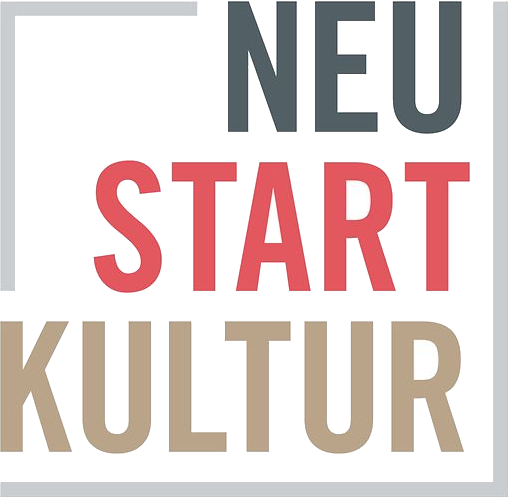FLAG
Group Show featuring Frank Ahlgrimm, Nú Barreto, Tim Berresheim, Harald Braun, Marc Brickman, Anne-Lise Coste, Sinje Dillenkofer, Magnus Gjoen, huber.huber, Samson Kambalu, Robert Longo, Josephine Meckseper, Matt Mullican, Julio Rondo, Slavs and Tatars, Fredrik Værslev
22.11.2024 - 31.01.2025
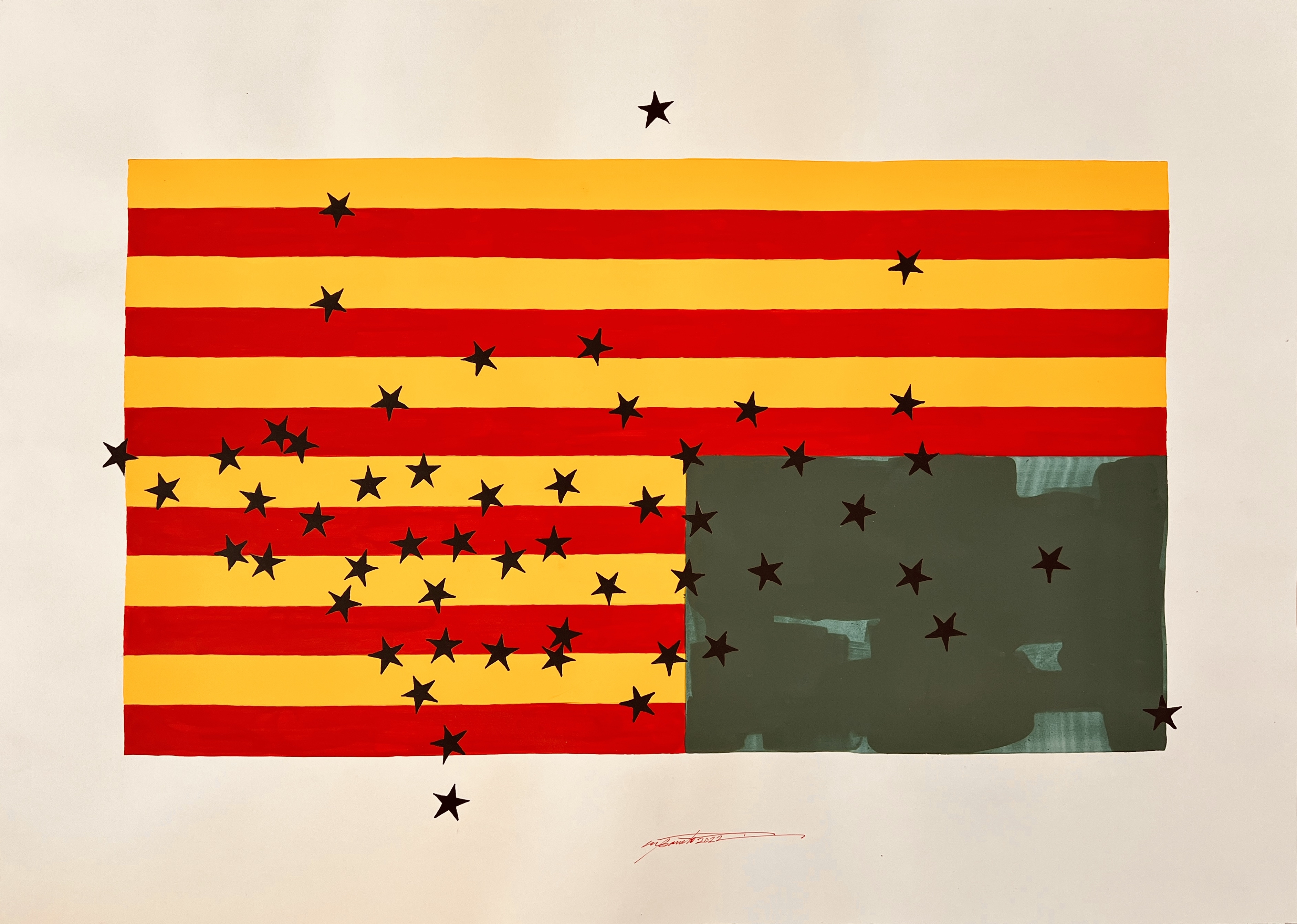
Stellen Sie sich ein modernes Schlachtfeld vor, das von Militärfahrzeugen verwüstet, mit Granatsplittern übersät und von den letzten Überlebenden verlassen wurde. Darüber flattert eine einsame Flagge im Himmel – ein ambivalentes Zeichen von Frieden und Zerstörung. Obwohl unbekannt ist, wie und wann sie entstand, ist eine Flagge das am weitesten verbreitete Signal der Menschheit. Sie kann ein Versprechen des guten Willens oder ein Omen des Untergangs sein. Stellen Sie sich nun all die Flaggen vor, die über Tausende von Jahren gehisst wurden… Einige sind jetzt in Stücke gerissen, andere müssen noch gewebt werden. Ihre Farben vermischen sich und bilden eine unerschöpfliche Palette, angereichert mit Blut, Schweiß und Tränen. Nicht weit entfernt von der heutigen militärischen Kriegsführung greift die Gruppenausstellung FLAG in der Galerie Elisabeth & Reinhard Hauff die Flagge als zentrales Motiv auf. Die ausgestellten Flaggen unterscheiden sich in ihren Mustern und in ihrer Darstellung und erzählen Geschichten von verzehrenden Mächten, suggestiver Politik und ironischen Begegnungen.
In der Lichtskulptur Roundel Nullis Terminus, 2024 präsentiert Marc Brickman – der weltberühmte Lichtdesigner zweier olympischer Spiele und Konzertbühnen für Topmusiker wie Pink Floyd – „Licht, das in kontinuierlicher Zirkularität fließt – eine Landschaft ohne Grenzen, die sich jeder Besitzfrage widersetzt und den Betrachter auffordert, sich eine grenzenlose Gesellschaft vorzustellen. Eine Anti-Flagge“. Aber es ist Marc Brickmans Videoarbeit May 1, 2015 (excerpt) – die Kurzfassung seiner hybriden Lichtkunstinstallation für das Whitney Museum und das Empire State Building in New York mit einem der vielleicht ikonischsten amerikanischen Flaggenwerke der Kunstgeschichte, Jasper Johns Three Flags, 1958, welches als quasi Ready-made eingefügt ist –, und die Besucher beim Betreten der Ausstellung begrüßt. Der Kontrast zwischen dem monumentalen Gebäude, dem Sitz der amerikanischen Macht, und der Durchdringlichkeit des Lichts der Flagge erzeugt eine Energiequelle. Das mit Licht bemalte Empire State Building schreit nach Nationalität, Patriotismus und potenziellem Chauvinismus. Es ist ein amerikanisches Wahrzeichen, das im Zusammenspiel mit den anderen Exponaten der Ausstellung betrachtet werden sollte. Das Werk Bicephalic (2018) des in Berlin lebenden Künstlerduos Slavs and Tatars ist eine Flagge, die einen goldenen doppelköpfigen russischen Adler auf einem Bisexualität repräsentierenden Trikolore-Muster zeigt. Die kämpferische Haltung der russischen Regierung gegenüber ihrer LGBTQI+-Community nährt die Polemik des Kunstwerks. Einerseits ist Russland eines der räuberischsten Länder der Gegenwart mit einem Adler, der einen unersättlichen Appetit symbolisiert. Andererseits, so Slavs and Tatars, „überlagert Bicephalic Russlands besondere Position in Europa und Asien, als Selbst und Anderes auf die bisexuelle Flagge und plädiert für eine geopolitische Identität durch nicht-binäre Sexualität“. Die politischen Untertöne sind auch in Matt Mullicans ikonischem Sign Flag 36" x 72", 1980, zu entdecken. Die visuellen Ähnlichkeiten mit der Hakenkreuzfahne der Nationalsozialismus sind kaum zu übersehen. Anstelle eines schwarzen Hakenkreuzes sieht man ein mysteriöses schwarzes Symbol, das Mullican entwickelt hat und in seinem Werk wiederholt darstellt. In Mullicans Werk hat jede Farbe einen bestimmten symbolischen Wert. In einem seiner Systeme stehen Weiß und Schwarz für Sprache und Rot für das Subjektive. Obwohl die genaue Semiotik von Mullicans Werk schwer zu erkennen ist, erzeugt das Werk positive Spannungen mit anderen in der Ausstellung gezeigten Arbeiten. In Versuch, 2017, des Zürcher Künstlerduos huber.huber, wird eine schwarze Flagge in Bleiche getaucht, wodurch der untere Teil der schwarzen Flagge weiß wird. Eine schwarze Flagge hat mehrere metaphorische Bedeutungen. Im Westen werden die schwarzen Flaggen mit Trauer und Tod in Verbindung gebracht. Man könnte eine schwarze Flagge auf einem Piratenschiff wehen sehen. Die Farbe der Flagge kann auch mit der Hautfarbe in Verbindung gebracht werden. Das Bleichen suggeriert von sich aus, dass die Flagge irgendwie verunreinigt ist oder eine Verunreinigung darstellt und daher durch das Weißwaschen gereinigt werden soll. Wie Patrizia Keller vorschlägt, stellt sie „einen Versuch dar, das Böse selbst zu besiegen“. Sie kann weiter als Experiment von Generationen weißer Rassisten zur Ausrottung dunkelhäutiger Menschen verstanden werden. Die Bleichmitteldosis muss jedoch genau richtig sein, um Schwarz in Weiß zu verwandeln. Es ist ein schwieriger Balanceakt, bei dem das Negative positiv wird und umgekehrt. Die Arbeit von huber.huber ist nicht zynisch, sondern eher ironisch und steht auch als Sinnbild dafür, wie wir Geschichte neu schreiben. Der gefeierte, in Malawi geborene Samson Kambalu – Professor der Bildenden Künste in Oxford und Künstler der berühmten Skulptur Antelope auf dem vierten Sockel des Trafalgar Square – erschafft seit einigen Jahren eine Reihe von imaginären Flaggenkompositionen in leuchtenden, kräftigen Farben mit minimalistischen Mustern. Er greift auf farbenfrohe Bilder von Bonbonpapieren und afrikanischen Stoffen aus der Kindheit zurück, streut schelmische Symbole ein, die keine Flaggen sind, wie Bat Down Nation Green, 2022 zeigt – und hängt die Flaggen auf eine ungewöhnliche Art und Weise auf, die für Flaggen unüblich ist, sodass eine gewisse Missachtung gegenüber dem traditionellen kolonialen Besitzanspruch vermittelt wird. In einer Gruppe von vier Werken von Nú Barreto (geboren in Guinea-Bissau, lebt und arbeitet in Paris) sehen wir wandernde Sterne auf einer auf den ersten Blick amerikanischen Flagge, die ihre üblichen Plätze verlassen haben. Die Sternenkonglomerate überschreiten das erkennbare Streifenmuster der Fahne, die Farben der weißen und roten Streifen wurden jedoch in Gelb und Rot übersetzt. Der Titel der Arbeit Alle Wege führen nach Afrika, 2022 ist vielleicht ein Versuch des Künstlers, die verflochtene und komplizierte Geschichte der beiden Kontinente zu kommentieren. Die Sterne, die die amerikanischen Staaten darstellen sollen, wandern in verschiedene Richtungen und deuten auf Vertreibung und mögliches Exil hin, etwas, das die afrikanische Bevölkerung in Amerika bis hin zur Skaverei erleiden musste. Die Flaggenbilder des norwegischen Künstlers Fredrik Værslev sind über längere Zeiträume rauen Wetterbedingungen ausgesetzt gewesen, sodass sie durch die Elemente widerstandsfähiger geworden sind und Spuren der Abnutzung und eines gelebten Lebens angenommen haben. Værlsev ließ sich für diesen Schaffensprozess von seinem Landsmann Edvard Munch inspirieren. Diese sehr persönliche Technik verleiht den Flaggenkompositionen Trinidadand Tobago und Usbekistan – zwei Werke aus Værslevs 2020er-Serie World Paintings – eine faszinierende Oberflächendichte, sowie Materialität. Seine Arbeiten konfrontieren uns mit den Fragen: Was bedeutet Nation, ein Nationalgefühl, nationale Zugehörigkeit, nationalistischer Eifer, nationale Grenzen und territoriale Zugehörigkeit? Værslev ist der Meinung, dass „eine Flagge natürlich auch „nur“ ein Gemälde sein kann“.
In Frank Ahlgrimms Gemälden sehen wir verschmutzte weiße olympische Flaggen, die auf den mörderischen Anschlag des Münchner Massakers an den Olympischen Spielen 1972 anspielen. Die weiße Flagge ist ein Tabula rasa, die je nach Kontext für vieles stehen kann. Sie kann ein Hintergrund für Frieden ebenso wie für Gewalt sein, wie dies auch Magnus Gjoen in seiner Arbeit Wave Your Flag High, We Shall Stand Together, 2024 präsentiert. Angesichts der gegenwärtigen Turbulenzen in der Welt ist das Hissen einer weißen Flagge ein Zeichen für Frieden – eine dringend notwendige Maßnahme. Schwarz ist die dunkelste Farbe. Schwarz ist ein Leitmotiv von FLAG, wie bei Robert LongosStudy for Black Flag #5 von 1989. Wir sehen das Schwarz hell leuchten in den meistgenannten Werken sowie in Flaggen von Künstlern wie Tim Berresheim, AAWNK Scholle gehisst – Flagge, 2020, Sinje Dillenkofer, The Danish Flag 1, 2019, Josephine Meckseper, German Flag No. 2, 2001 und Anne-Lise Coste, France Go Home, 2009. Man könnte sagen, es porträtiert die Show mit dunklen Strichen. Man könnte sogar sagen, es ist aktuell und auf den Punkt gebracht, da wir in sehr düsteren und dunklen Zeiten leben. Letzten Endes bleibt eine Gruppe außergewöhnlich starker Werke von Weltklasse-Künstlern. Und wie Julio Rondos wunderschöne Komposition 2024 zeigt: FLAG is „only“ a Four Letter Word (FLAG ist „nur“ ein Wort mit vier Buchstaben)!
Text: Paulius Andriuškevičius undnd Elisabeth Hauff (Übersetzung ins Deutsche: Cornelia Schuster).
Ohne die großzügige und freundschaftliche Zusammenarbeit aller beteiligten Künstler und der sie vertretenden Galerien hätte diese Gruppenausstellung nicht zustande kommen können. Wir bedanken uns recht herzlich bei Andersen’s Contemporary, Kopenhagen, der Galerie Kraupa-Tuskany Zeidler, Berlin, der Galerie Mehdi Chouakri, Berlin und der Galerie Nathalie Obadia, Paris/Brüssel.
Zur Eröffnung laden wir Sie herzlich am Freitag, den 22. November 2024, von 18 bis 21 Uhr ein.
Abbildung: Detail von Nú Barretos „Tous les chemins mènent en Afrique“, 2022, 4-teilig, Acryl auf Rosaspina-Papier, je 70 x 100 cm (ungerahmt), Courtesy: der Künstler, Galerie Nathalie Obadia Paris/Brüssel.
Picture a modern battlefield ravaged by military vehicles, littered with shrapnel, and abandoned by the last surviving men. Above it a lonely flag flutters in an open sky – an ambivalent sign of peace and destruction. Although it is unknown how and when it came about, a flag is the most established signalling device of humankind. It can be a promise of goodwill or an omen of ruin. Now imagine all the flags that shimmered over thousands of years… Some are now torn to pieces, others yet to be woven. Their colours blend creating an inexhaustible palette enriched by blood, sweat and tears. Not too far from today's military warfare, the group show FLAG at Galerie Elisabeth & Reinhard Hauff takes up the flag as its central motif. Different in their patterns and delivery the flags exhibited tell stories of consuming powers, suggestive politics, and ironic encounters.
In the light sculpture Roundel Nullis Terminus, 2024, Marc Brickman – the world famous light designer of two Olympic games and concert stages for top musicians like Pink Floyd – "envisions light flowing in continuous circularity – a borderless landscape territory that defies ownership and asks the viewer to imagine a boundless society. An Anti-Flag". But it is Marc Brickman's video work May 1, 2015 (excerpt) – the short version of his hybrid lighting art installation for the Whitney Museum and the Empire State Building with one of the perhaps most iconic American flag pieces in art history, Jasper John's Three Flags, 1958, inserted as a quasi ready-made – which welcomes visitors when entering the exhibition. The contrast between the monumental building, the seat of American power, and the fragility of the flag light fabric is a source of energy. The light painted Empire State Building screams of nationality, patriotism, and potential chauvinism. It is one truly American landmark to behold in the context of the rest of the exhibition. The Berlin based artist duo Slavs and Tatars' work Bicephalic, 2018, is a flag that exhibits a golden double-headed Russian eagle on a background of the bi-sexual tricolour pattern. The combative stance of the Russian government against its LGBTQI+ community feeds the polemics of the artwork. On the one hand, Russia is one of the most predatory contemporary countries with an eagle that has an insatiable appetite as its symbol. On the other hand, as Slavs and Tatars state, "Bicephalic layers Russia's particular position as Europe and Asia, self and other onto the bi-sexual flag, arguing for a geopolitical identity through non binary sexuality." The political undertones are also heard in Matt Mullican's iconic Sign Flag 36" by 72", 1980. It is hard to miss the visual similarities with the flag of Nazi Germany. However, instead of a black swastika, there is a mysterious black symbol that Mullican created and repeatedly depicts in his oeuvre. In Mullican's practice, every colour has a specific symbolic value. In one of his systems, white and black stand for language and red for the subjective. Although the exact semiotics of Mullican's work are hard to read, the work creates favourable tensions with other works presented in the show. In the Zurich artist duo huber.huber's work Experiment (Versuch), 2017, a black flag is partially submerged in bleach turning its lower part white. There are multiple metaphoric meanings of a black flag. In the West, the black flags are connected to mourning and death. One might see a black flag flying atop a pirate ship. The black colour of the flag can also be associated with skin colour. Bleaching it intrinsically suggests that the flag is somehow contaminated or is a contaminant and is therefore being purged by whitewashing. As Patrizia Keller suggests it represents "an attempt to defeat evil itself." It can further be understood as an experiment of generations of white supremacists to eradicate the black race. However, the bleach dosage must be just right to turn black into white. It is a tight balancing act in which the negative turns positive and vice versa. huber.huber's work is not cynical but rather ironic, seeing it also as an image of how we re-write history. The acclaimed Malawi born, Samson Kambalu – Oxford Professor of Fine Arts and creator of the famous Trafalgar Square Fourth Plinth sculpture Antelope – has been making series of imaginary flag compositions in vibrant colours and bold patterns for some years. He draws on colourful images of childhood candy wraps and African fabrics, interspersing mischievous non-flag symbols like Bat Down Nation Green, 2022 – and hanging the flags in non-flag hanging ways, signalling thereby some disdain towards traditional colonial pretense of ownership. In a group of four works by Nú Barreto (born in Guinea-Bissau, working in Paris) we see stars of what looks like the American flag at first glance leave their designated places. The star clusters cover the recognizable striped pattern, however, the colours of white and red stripes have been changed to yellow and red. The title of the work reads All Roads Lead to Africa, 2022. Perhaps it is an attempt by the artist to comment on the intertwined and complicated history of the two continents. The stars that are supposed to represent the American states wander in different directions hinting at displacement and potential exile, something the African people had to suffer in the foreign land. The flag canvases of Norwegian artist Fredrik Værslev are over longer periods exposed to harsh weather conditions so that they become fortified by the elements and take on the traces of use and a life lived. Værlsev partly took inspiration for this process of painting from his compatriot Edvard Munch. This very personal technique gives the flag compositions Trinidad and Tobago and Uzbekistan – two works from Værslev's 2020 World Paintings series – a fascinating surface density, a materiality. They confront us with questions such as: what is nationhood, a national feeling, national belonging, nationalist fervor, national borders, territorial belonging? In Værslev's opinion "of course a flag can also be "just" a painting". We do see smudgy white olympic flags in Frank Ahlgrimm's paintings related to the 1972 Munich Olympic Games in which murderous deeds were committed as part of the Munich massacre. The white flag is a tabula rasa – one that can stand for many things depending on the context – it can be a backdrop for peace as well as violence, as in Magnus Gjoen'sWave Your Flag High, We Shall Stand Together, 2024. With the current turmoil in the world, lifting a white flag and signaling for peace is a much-needed measure. Black is the Darkest Colour.Black is a leitmotif colour of FLAG. Look at Robert Longo'sStudy for Black Flag #5, from 1989. We see black shine brightly in the aforementioned works as well as in flags by artists, like Tim Berresheim, AAWNK Scholle gehisst – Flagge, 2020, Sinje Dillenkofer, The Danish Flag 1, 2019, Josephine Meckseper, German Flag No. 2, 2001 and Anne-Lise Coste, France Go Home, 2009. One might say that it portrays the show in dark strokes. One might even say it is timely as we live in dark times. When all is said, what remains is a group of exceptionally strong works by world-class artists. And as pointed out in Julio Rondo's beautiful 2024 composition: FLAG is a Four Letter Word!
Text: Paulius Andriuškevičius and Elisabeth Hauff
This show could not have come about had it not been for the generous and friendly collaboration of all the artists involved and the galleries representing them. We would like to express a heartful thanks to Andersen's Contemporary, Copenhagen, Galerie Kraupa-Tuskany Zeidler, Berlin, Galerie Mehdi Chouakri, Berlin and Galerie Nathalie Obadia Paris/Brussels.
We cordially invite you to our opening on Friday, November 22, 2024, from 6 to 9 p.m.
Image: Detail of Nú Barreto’s „Tous les chemins mènent en Afrique“, 2022, 4 parts, acrylic on paper rosaspina, each part 70 x 100 cm (unframed), Courtesy: the artist, Galerie Nathalie Obadia Paris/Brussels.
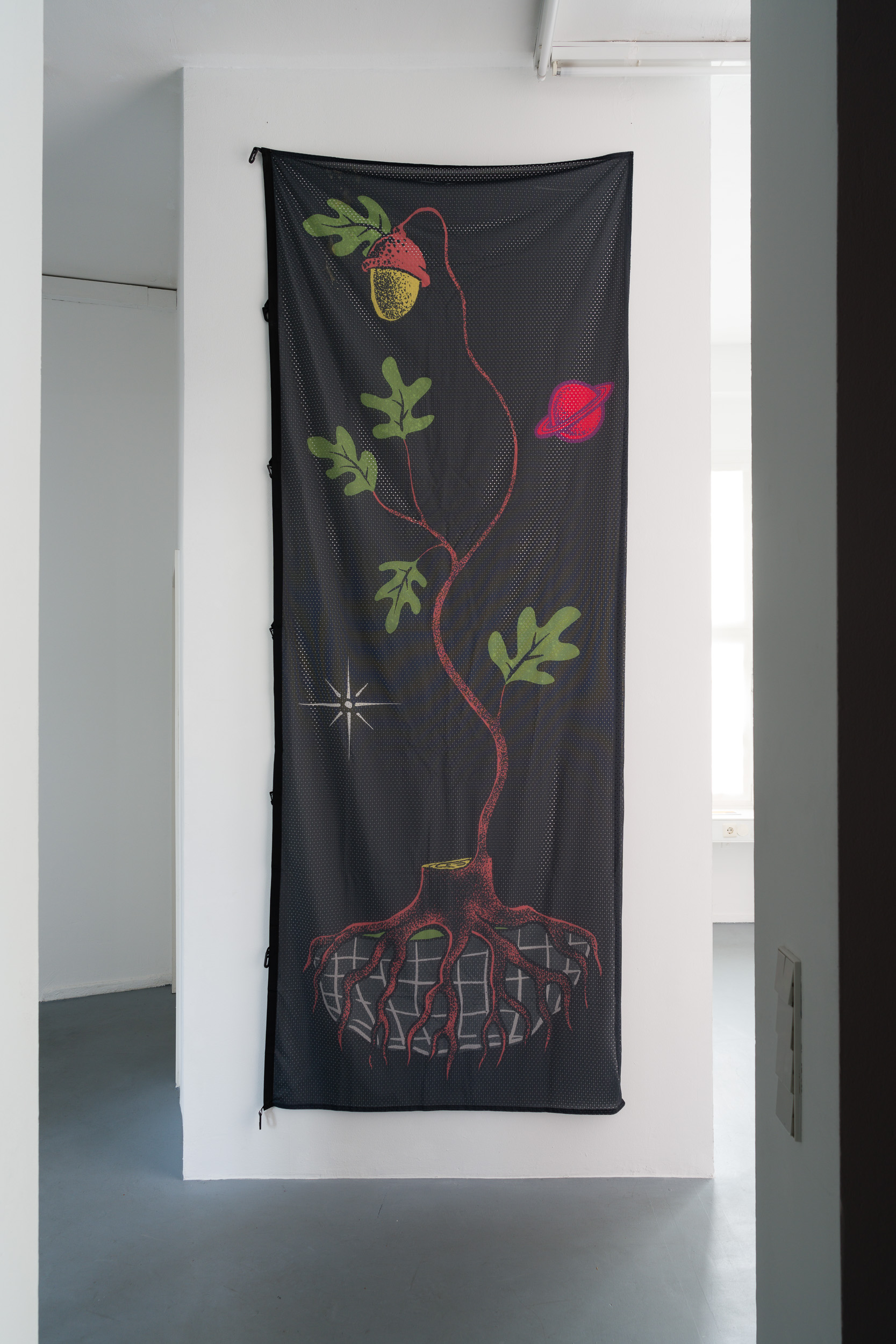
Exhibition view of Tim Berresheim’s „AAWNK Scholle gehisst – Flagge“, 2020, ed. no. 1/3, print on polyester fabric, 300 x 115 cm, photo: Bernhard Kahrmann.
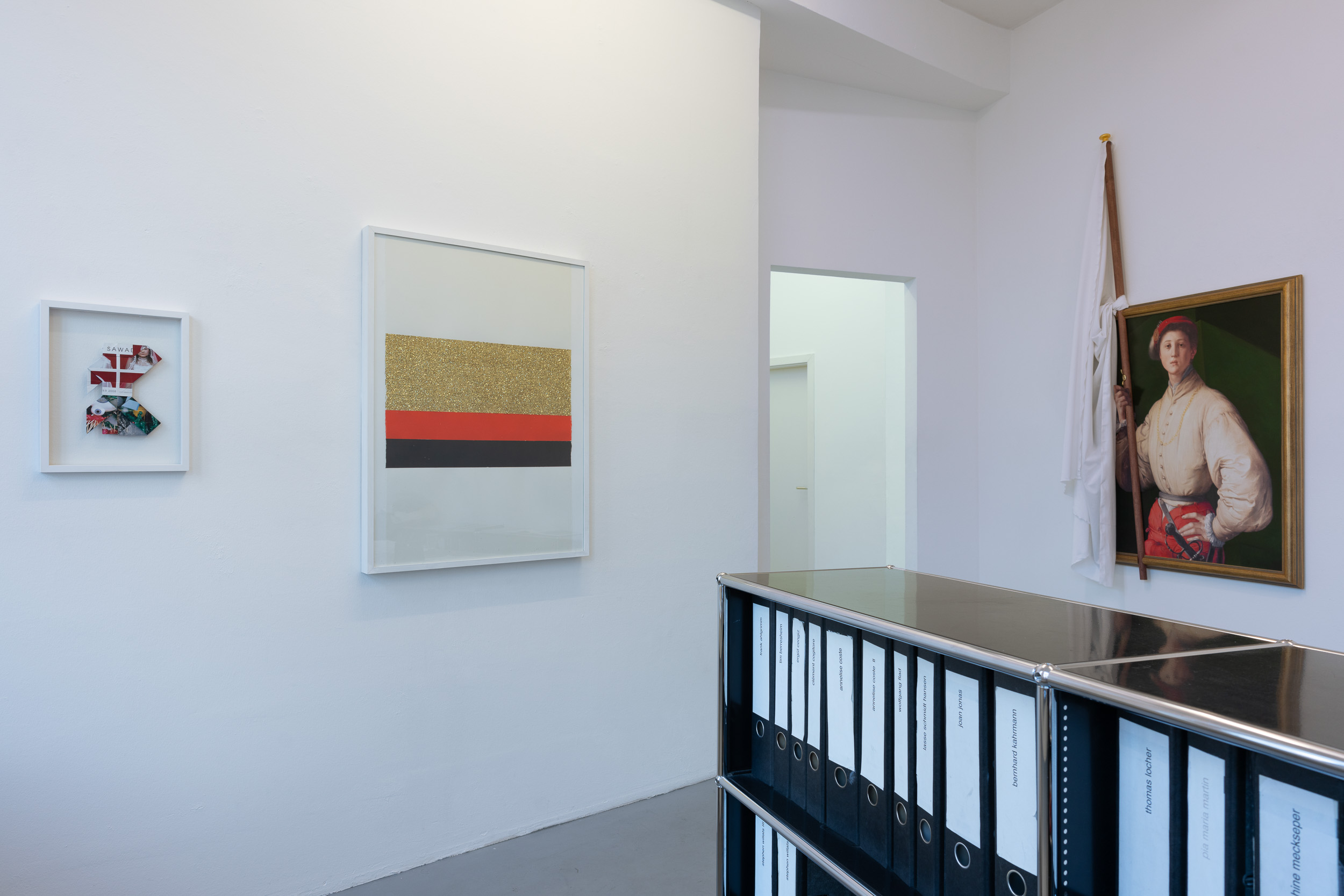
Exhibition view of Harald Braun’s „Untitled (Origami)“, 2022, Courtesy: the artist and private collection, and Josephine Meckseper’s „German Flag No. 2“, 2001, and Magnus Gjoen’s „Wave your flag high, we shall stand together“, 2024, Courtesy: the artist, photo: Bernhard Kahrmann.
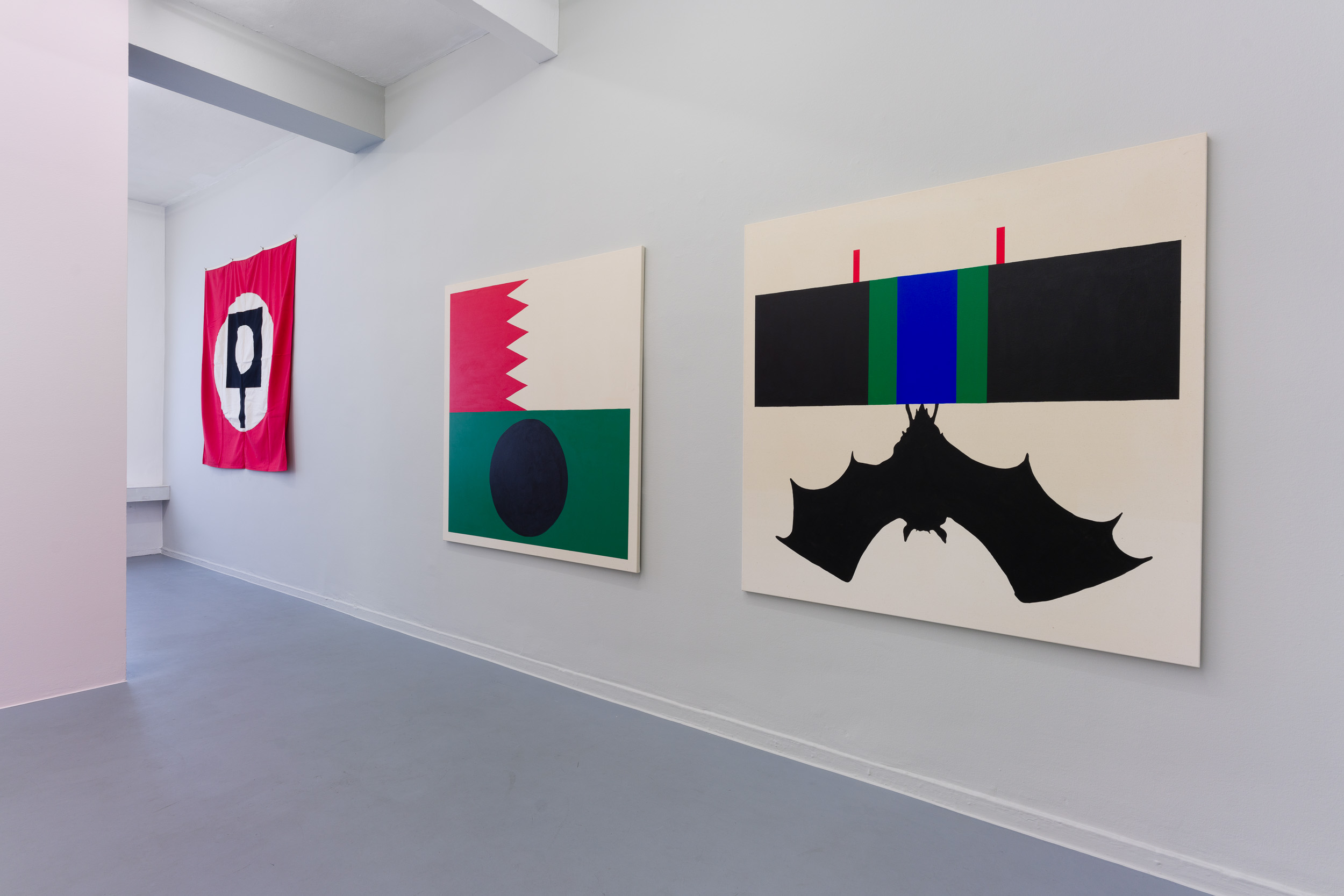
Exhibition view of Matt Mullican’s „Sign Flag 36" by 72"“, 1980, Courtesy: the artist and privat collection, and Samson Kambalu’s „Untitled“ and „Bat Down Nation Green“, 2022, Courtesy: the artist and Andersen’s Contemporary, Copenhagen, photo: Bernhard Kahrmann.
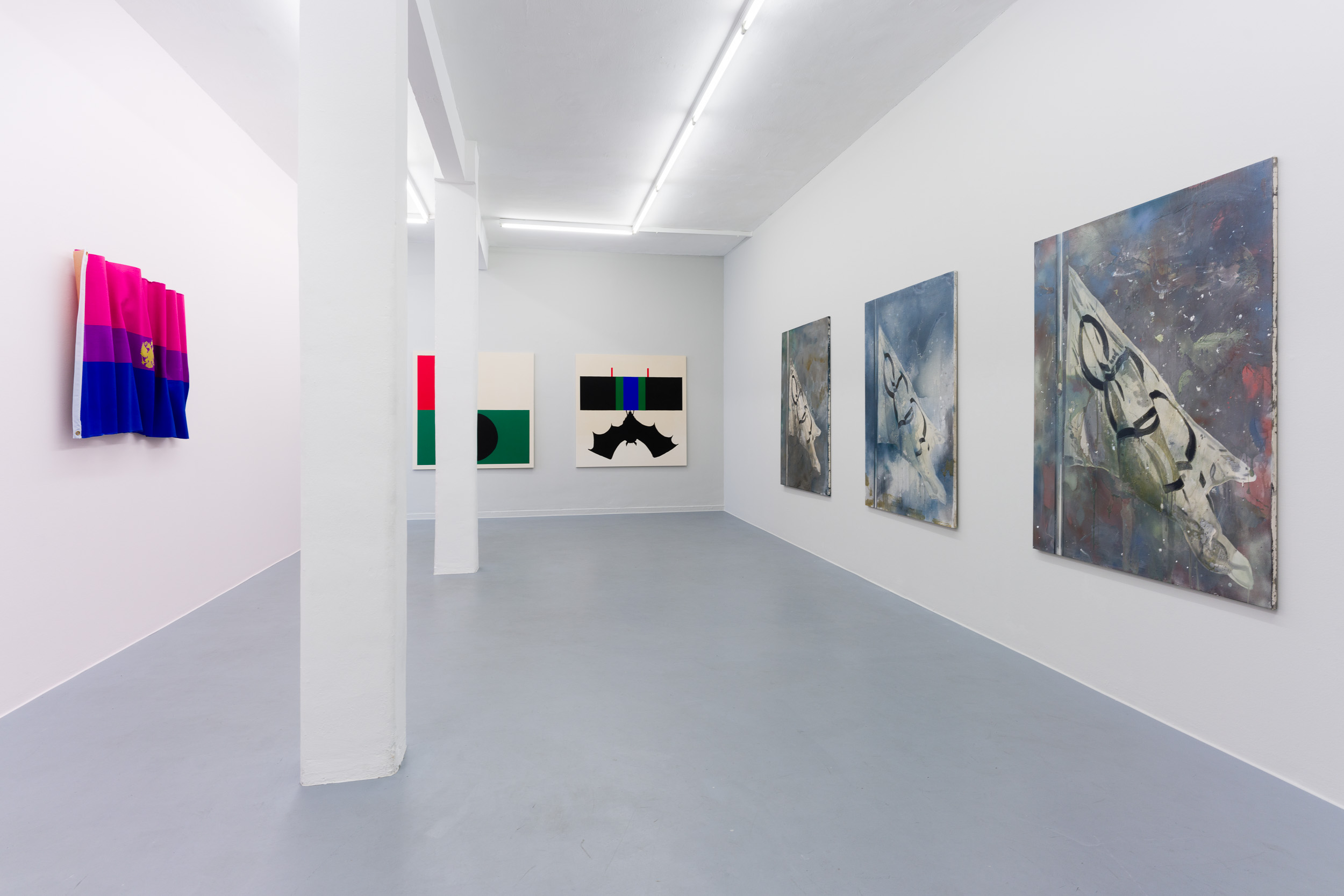
Exhibition view of Slavs and Tatars’ „Bicephalic“, 2018, Courtesy: the artist and Kraupa-Tuskany Zeidler, Berlin, and Samson Kambalu’s „Untitled“ and „Bat Down Nation Green“, 2022, Courtesy: the artist and Andersen’s Contemporary, Copenhagen, and Frank Ahlgrimm’s series „Halbmast“, 2011, photo: Bernhard Kahrmann.
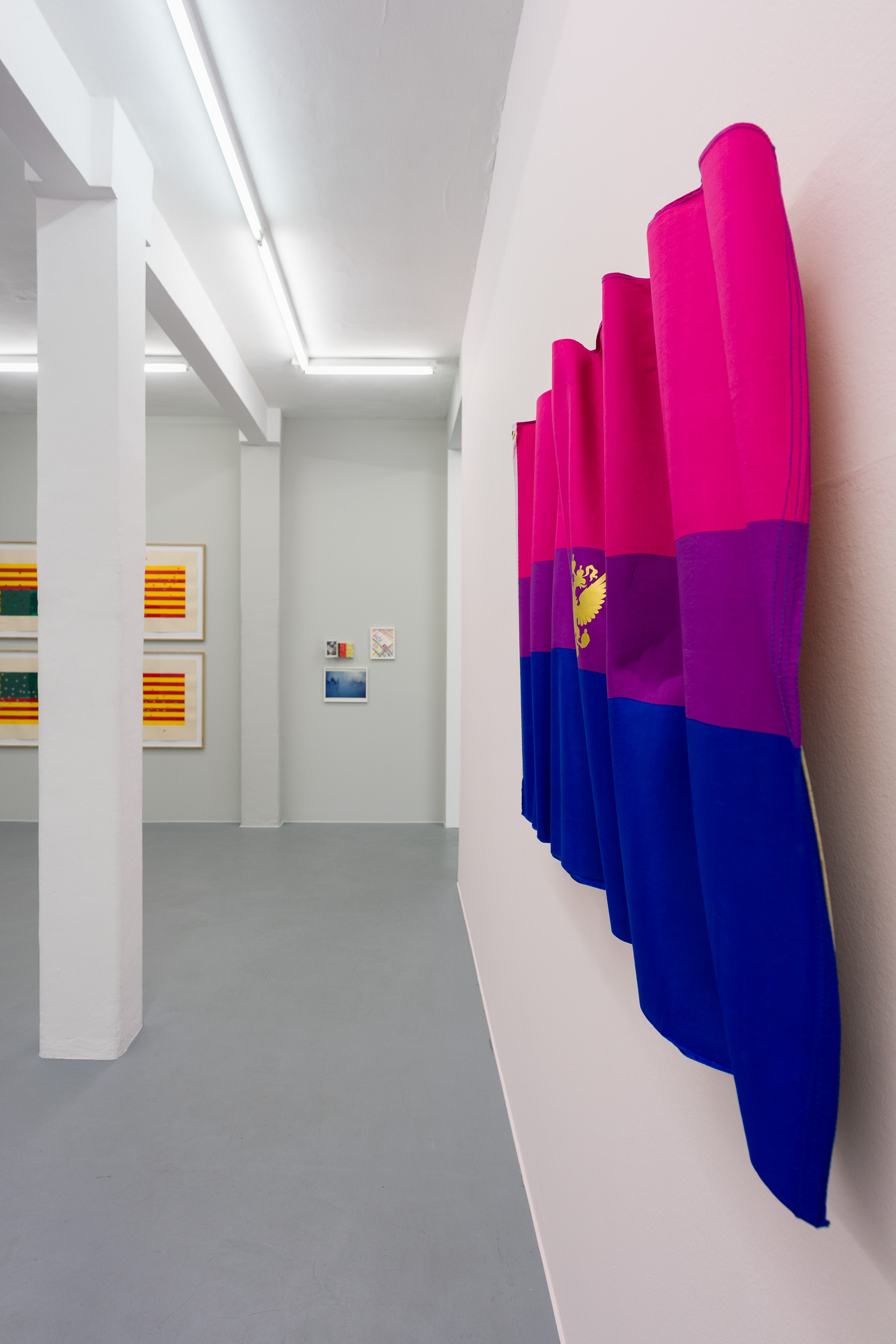
Exhibition view of Slavs and Tatars’ „Bicephalic“, 2018, ed. no. 12/25 + 5 AP, epoxy, resin, fibreglass, flag and acrylic paint, 110 x 130 x 20 cm, Courtesy: the artist and Kraupa-Tuskany Zeidler, Berlin, photo: Bernhard Kahrmann.
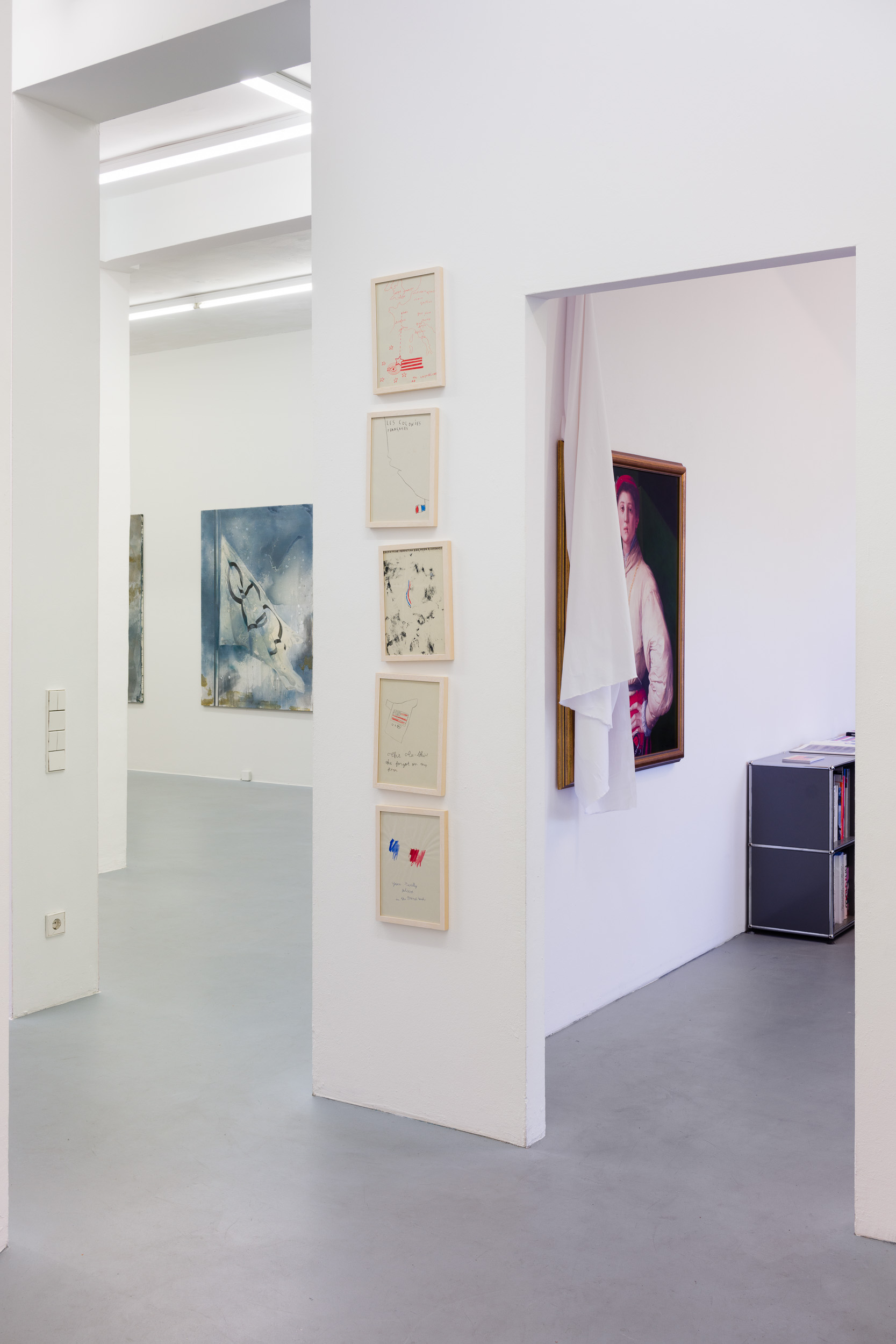
Exhibition view of Frank Ahlgrimm’s series „Halbmast“, 2011, and Anne-Lise Coste’s paper works, and Magnus Gjoen’s „Wave your flag high, we shall stand together“, 2024, Courtesy: the artist, photo: Bernhard Kahrmann.
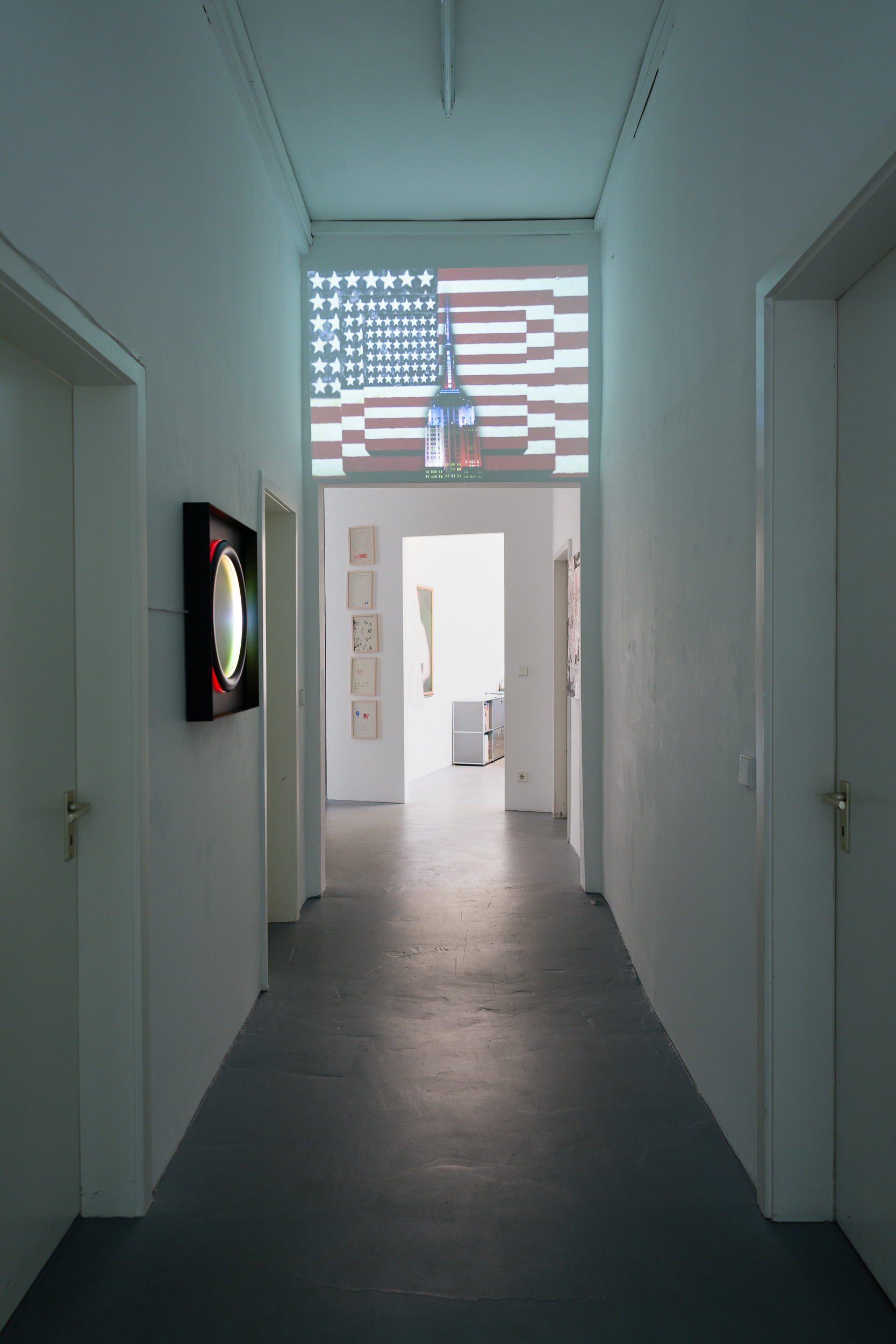
Exhibition view of Marc Brickman’s light sculpture „Roundel Nullis Terminus (Anti-Flag)“, 2024, and video „May 1, 2015 (excerpt)“, 2024, Courtesy: the artist, photo: Bernhard Kahrmann.
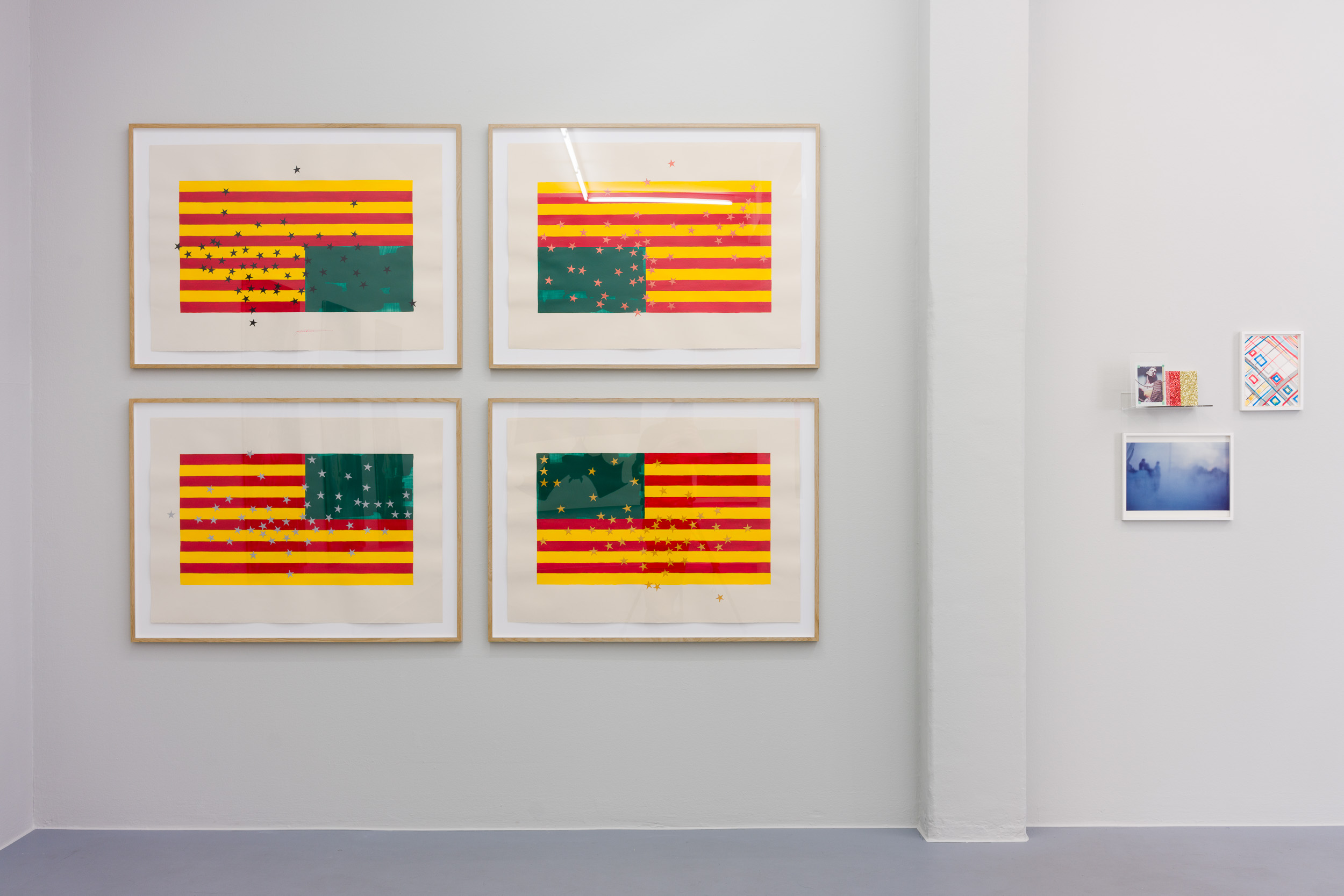
Exhibition view of Nú Barreto’s „Tous les chemins mènent en Afrique“, 2022, Courtesy: the artist and Galerie Nathalie Obadia, Paris/Brussels, and Josephine Meckseper’s „Untitled (Shelf #8)“, 2002, Courtesy: the artist and privat collection, photo: Bernhard Kahrmann.
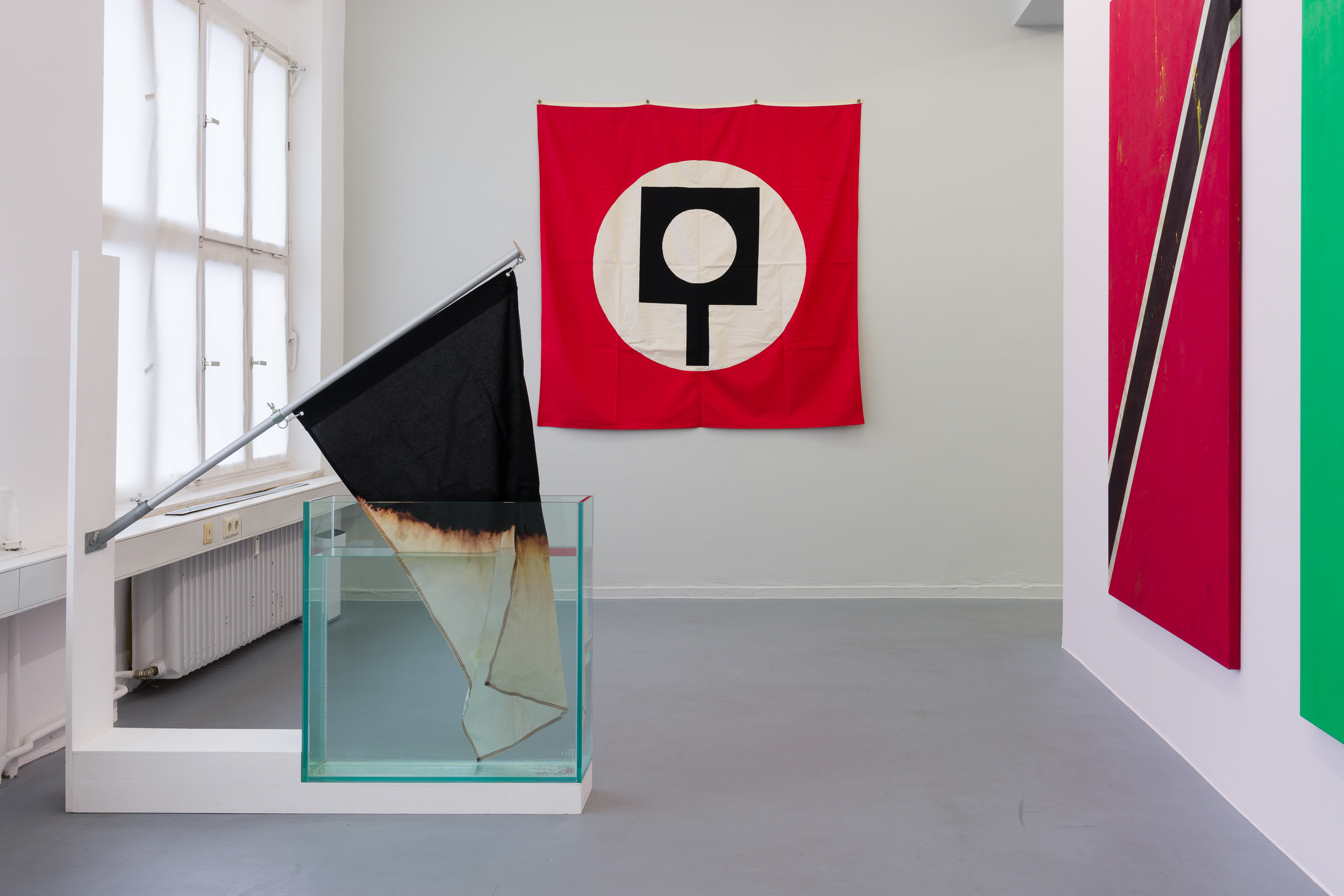
Exhibition view of huber.huber’s „Versuch“, 2017, Courtesy: the artists, and Matt Mullican’s „Sign Flag 36" by 72"“, 1980, Courtesy: the artist and privat collection, and Fredrik Værslev’s „Trinidad and Tobago“, 2020, Courtesy: the artist and Mehdi Chouakri, Berlin, photo: Bernhard Kahrmann.
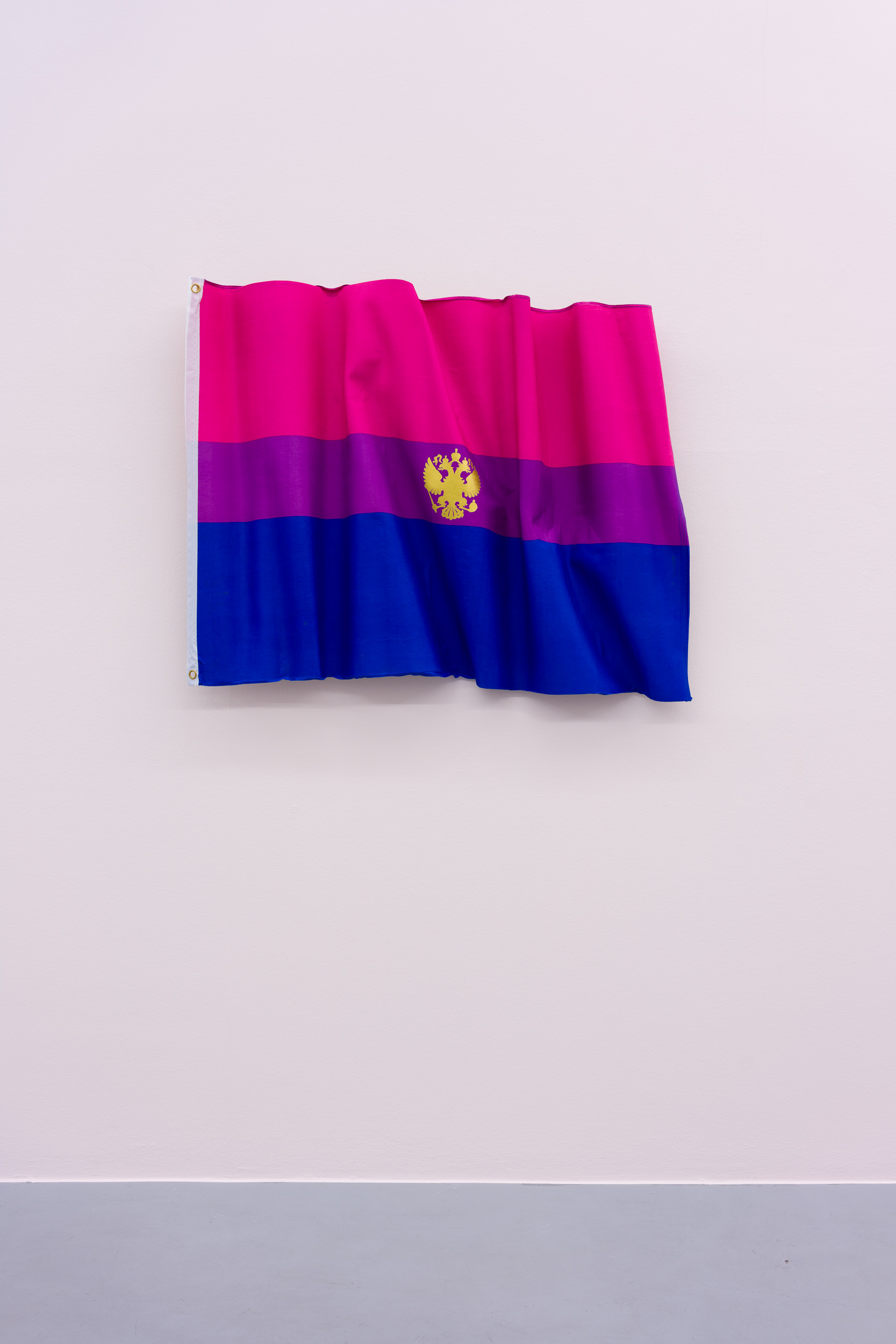
Slavs and Tatars’ „Bicephalic“, 2018, ed. no. 12/25 + 5 AP, epoxy, resin, fibreglass, flag and acrylic paint, 110 x 130 x 20 cm, Courtesy: the artist and Kraupa-Tuskany Zeidler, Berlin, photo: Bernhard Kahrmann.
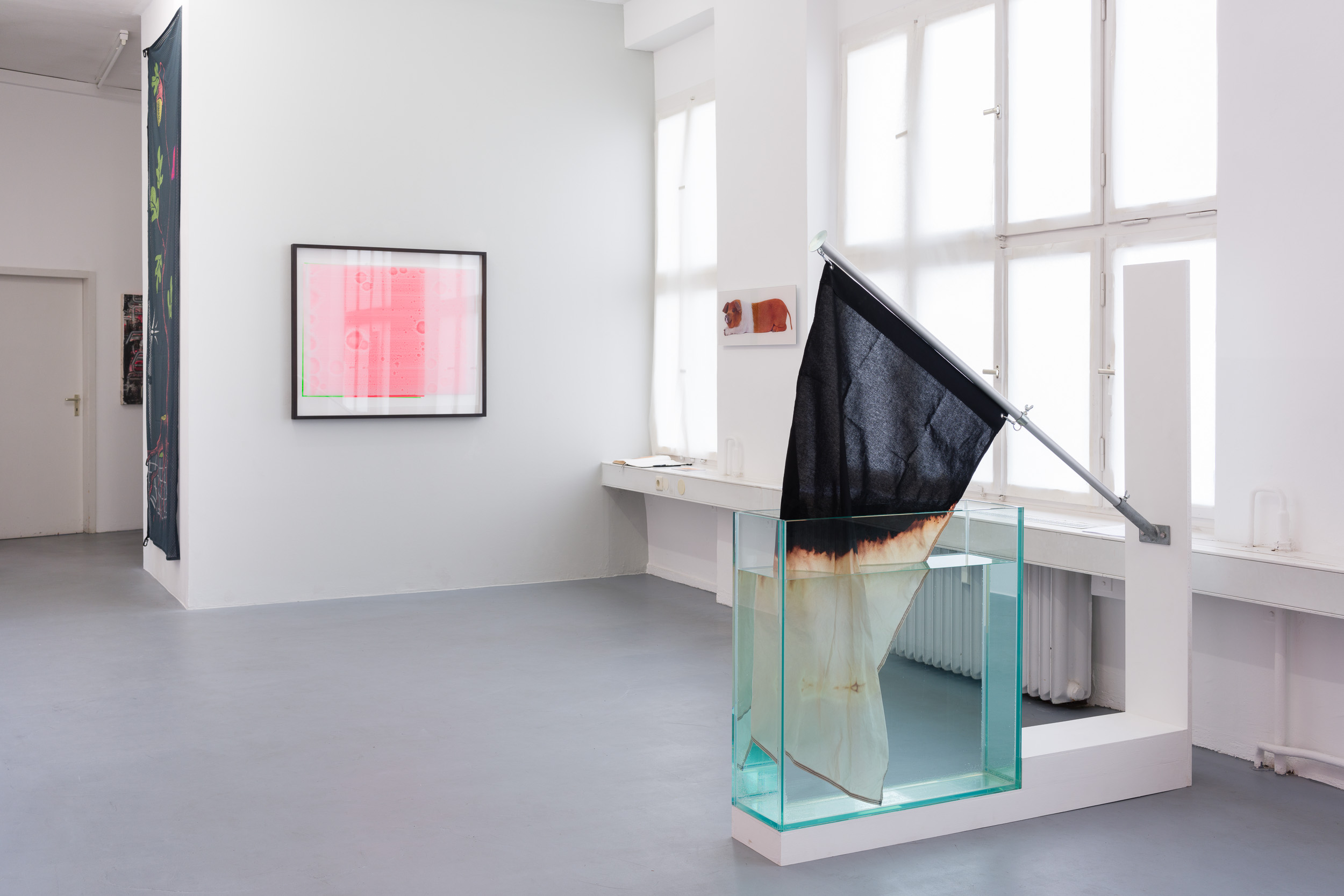
Exhibition view of Julio Rondo’s „Flag is a Four Letter Word“, 2024, and huber.huber’s „Versuch“, 2017, Courtesy: the artists, photo: Bernhard Kahrmann.
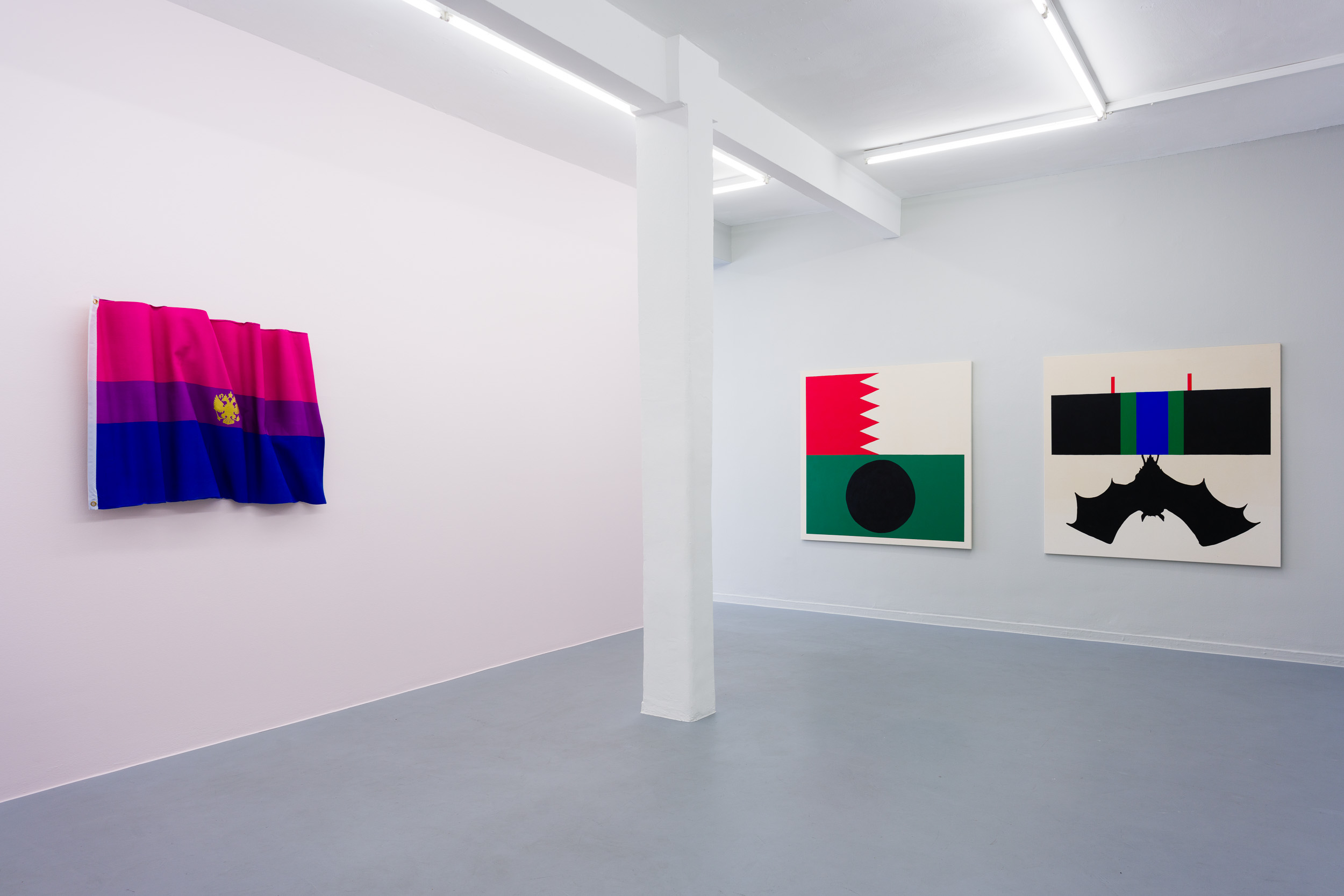
Exhibition view of Slavs and Tatars’ „Bicephalic“, 2018, Courtesy: the artist and Kraupa-Tuskany Zeidler, Berlin, and Samson Kambalu’s „Untitled“ and „Bat Down Nation Green“, 2022, Courtesy: the artist and Andersen’s Contemporary, Copenhagen, photo: Bernhard Kahrmann.
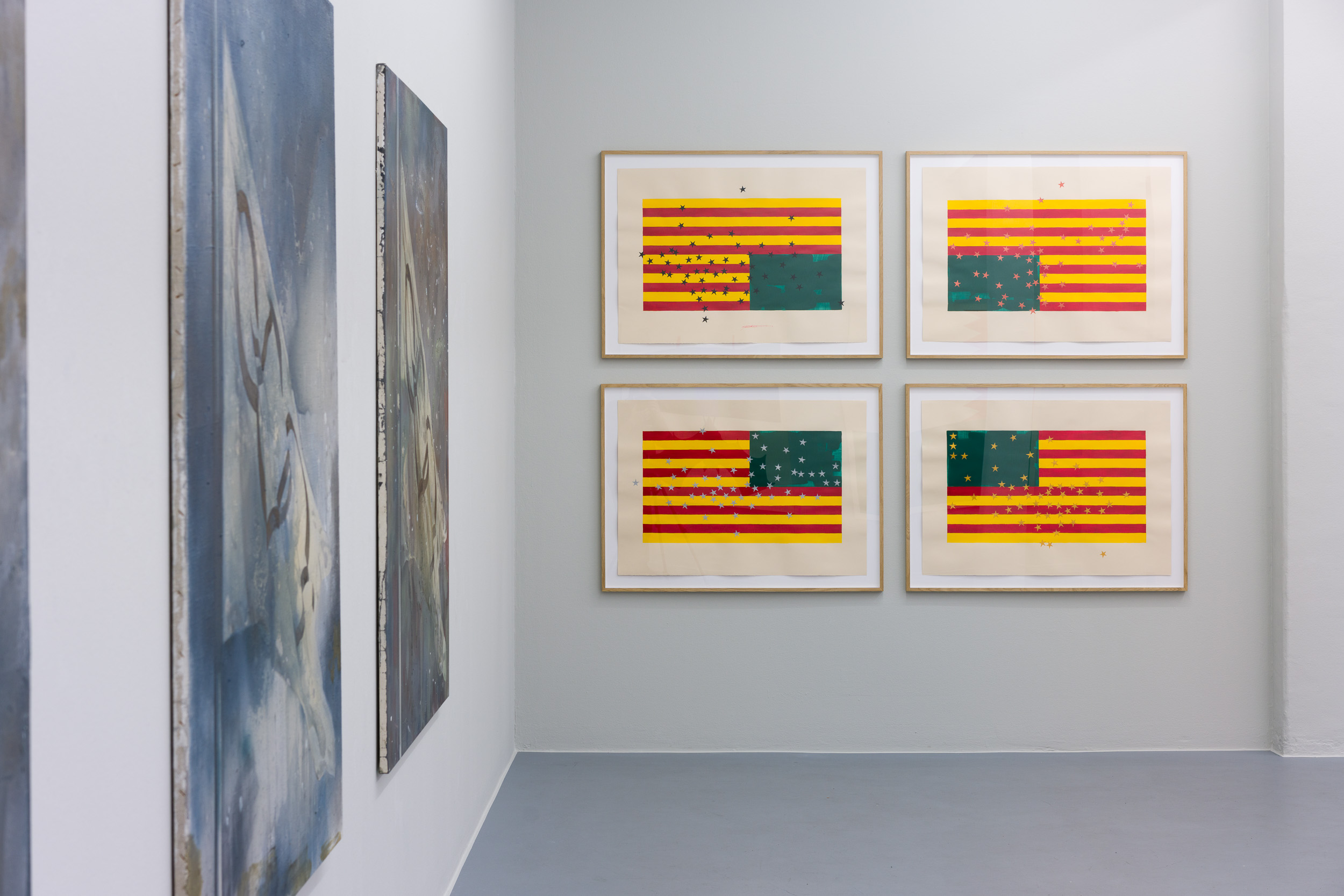
Exhibition view of Frank Ahlgrimm’s series „Halbmast“, 2011, and Nú Barreto’s „Tous les chemins mènent en Afrique“, 2022, 4 part work, acrylic on paper rosaspina, each paper 70 x 100 cm, framed each: 83 x 113 x 3 cm, Courtesy: the artist and Galerie Nathalie Obadia, Paris/Brussels, photo: Bernhard Kahrmann.
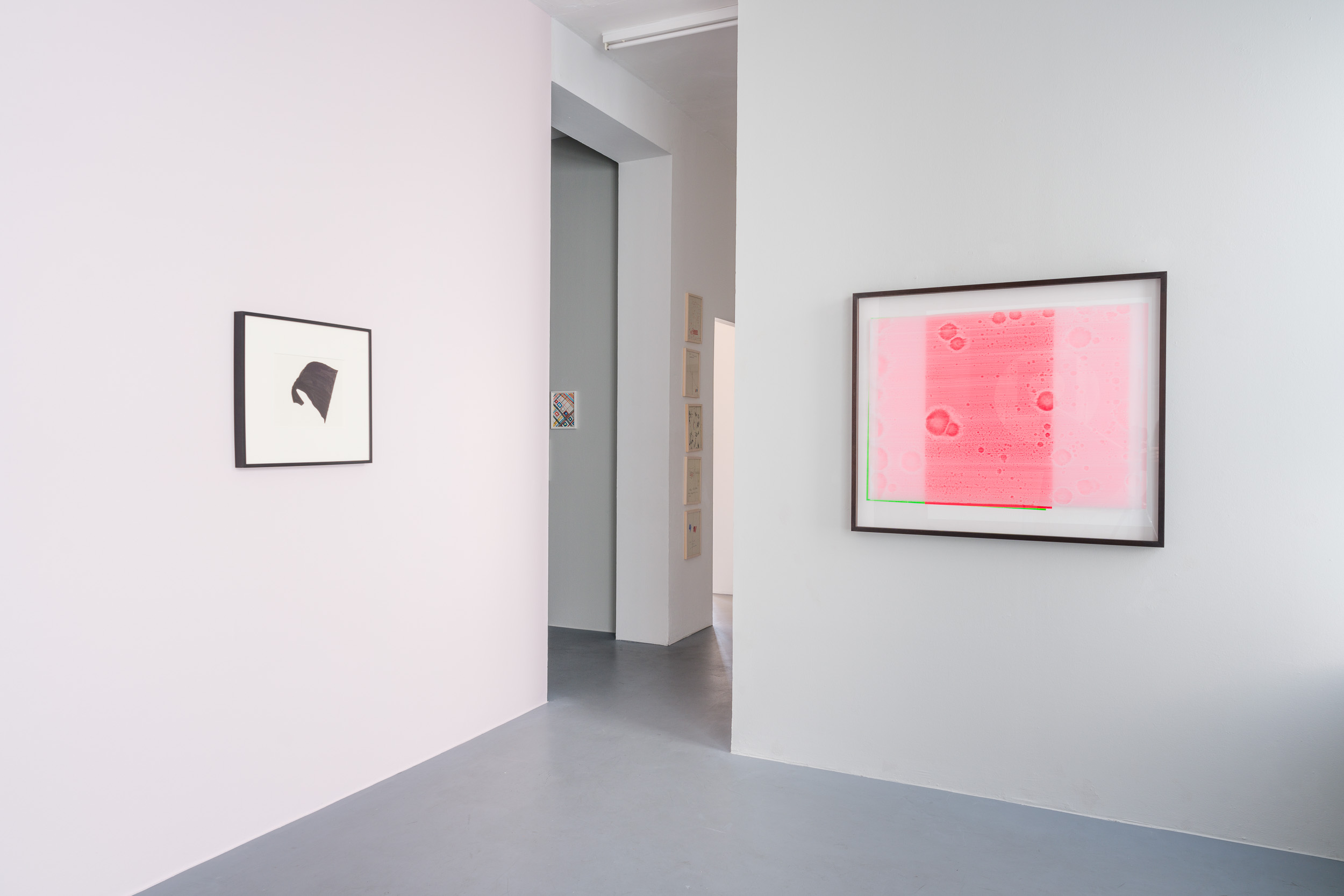
Exhibition view of Robert Longo’s „Study for Black Flag #5“, 1989, and Julio Rondo’s „Flag is a Four Letter Word“, 2024, photo: Bernhard Kahrmann.
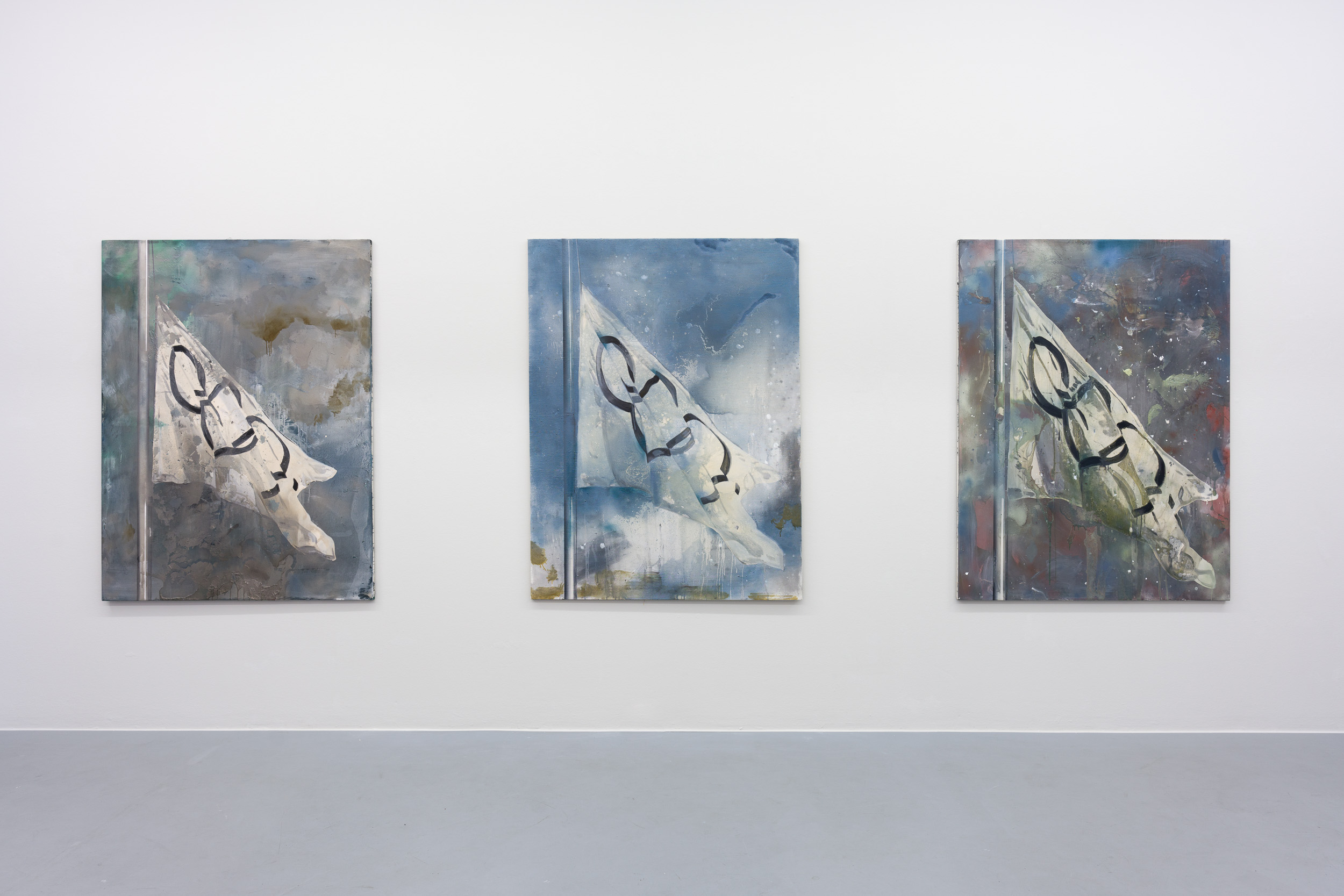
Exhibition view of Frank Ahlgrimm’s series „Halbmast“, 2011, oil, acrylic and lacquer on canvas, each 160 x 120 cm, photo: Bernhard Kahrmann.
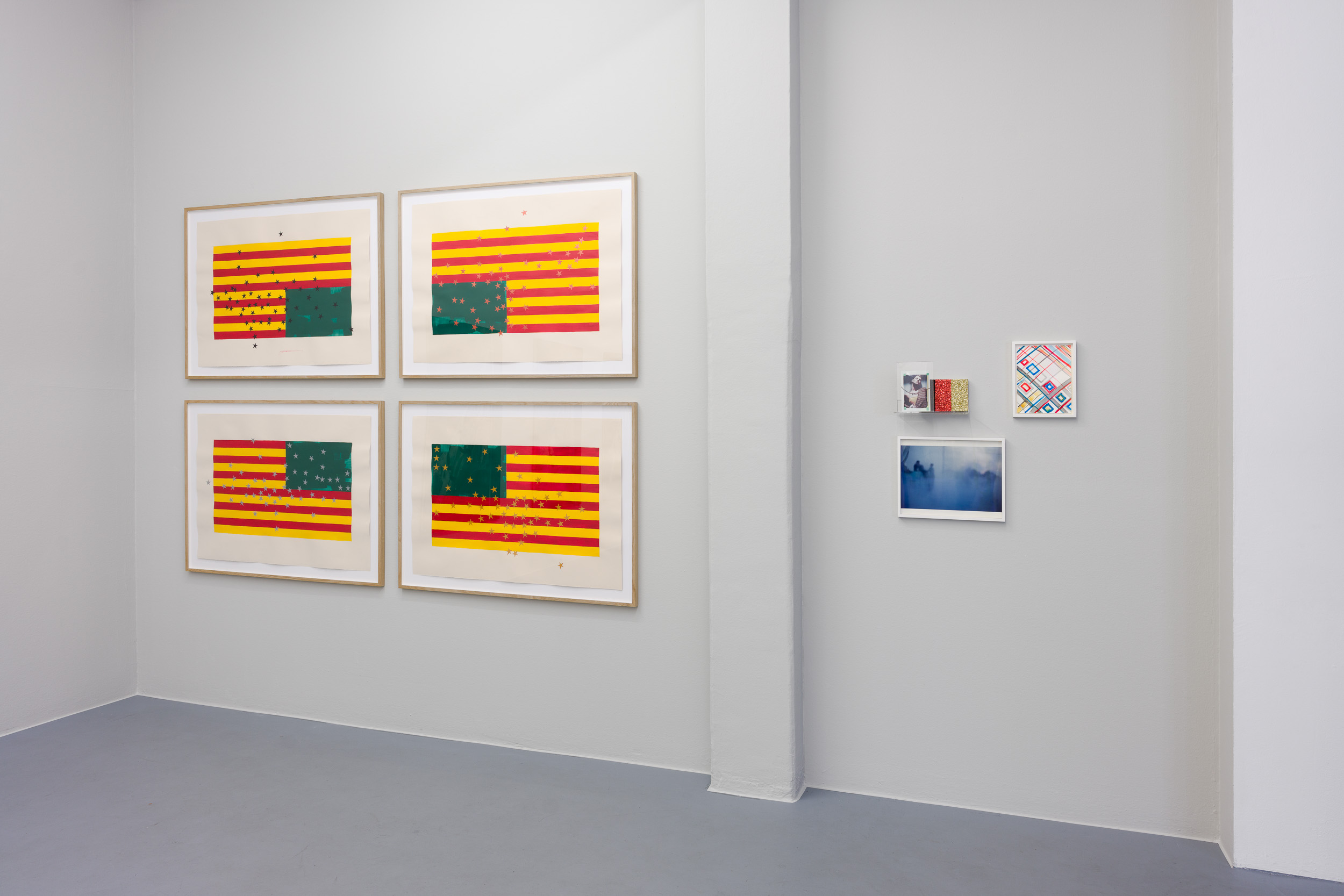
Exhibition view of Nú Barreto’s „Tous les chemins mènent en Afrique“, 2022, Courtesy: the artist and Galerie Nathalie Obadia, Paris/Brussels, and Josephine Meckseper’s „Untitled (Shelf #8)“, 2002, Courtesy: the artist and privat collection, photo: Bernhard Kahrmann.
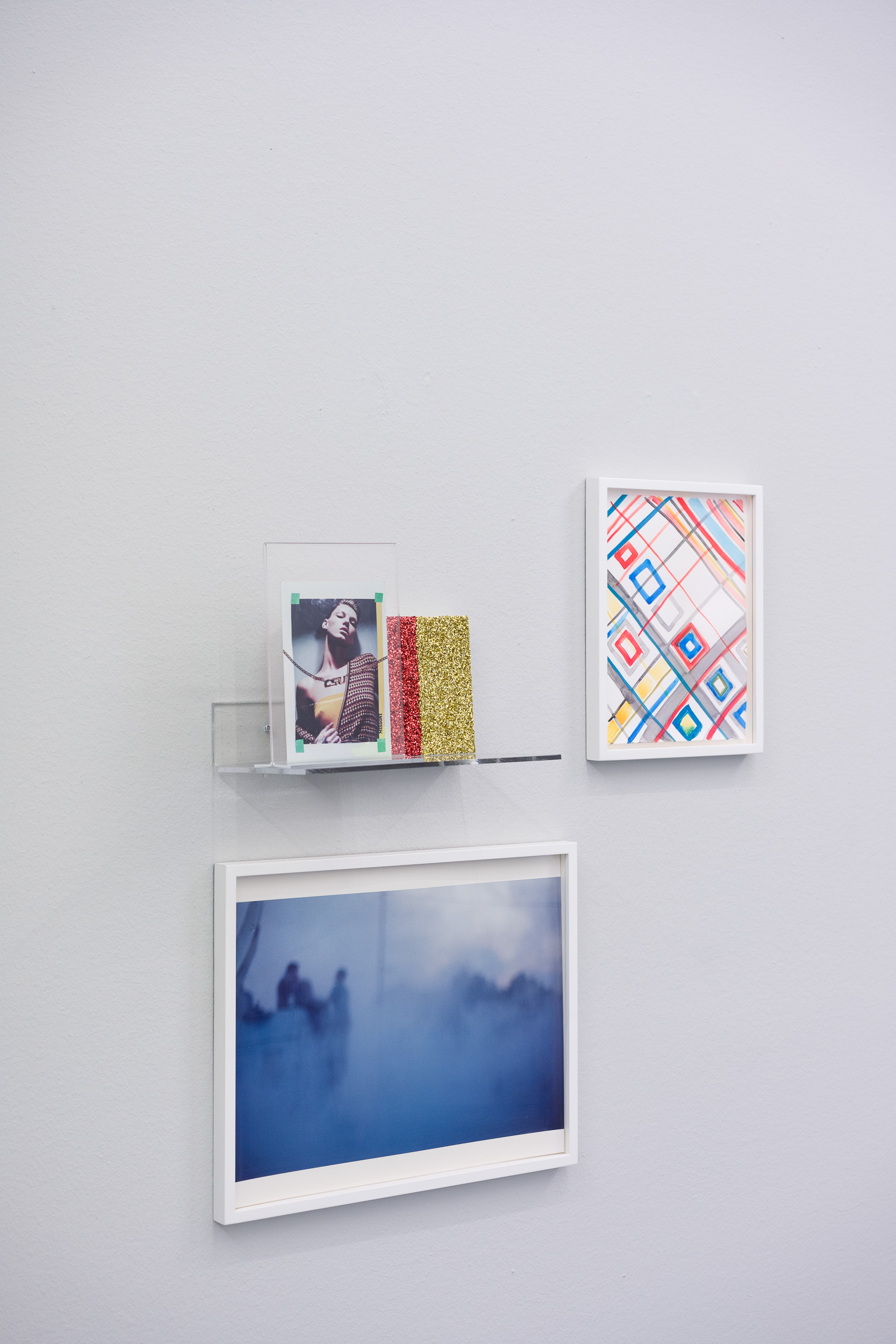
Josephine Meckseper’s „Untitled (Shelf #8)“, 2002, mixed media, Courtesy: the artist and privat collection, photo: Bernhard Kahrmann.
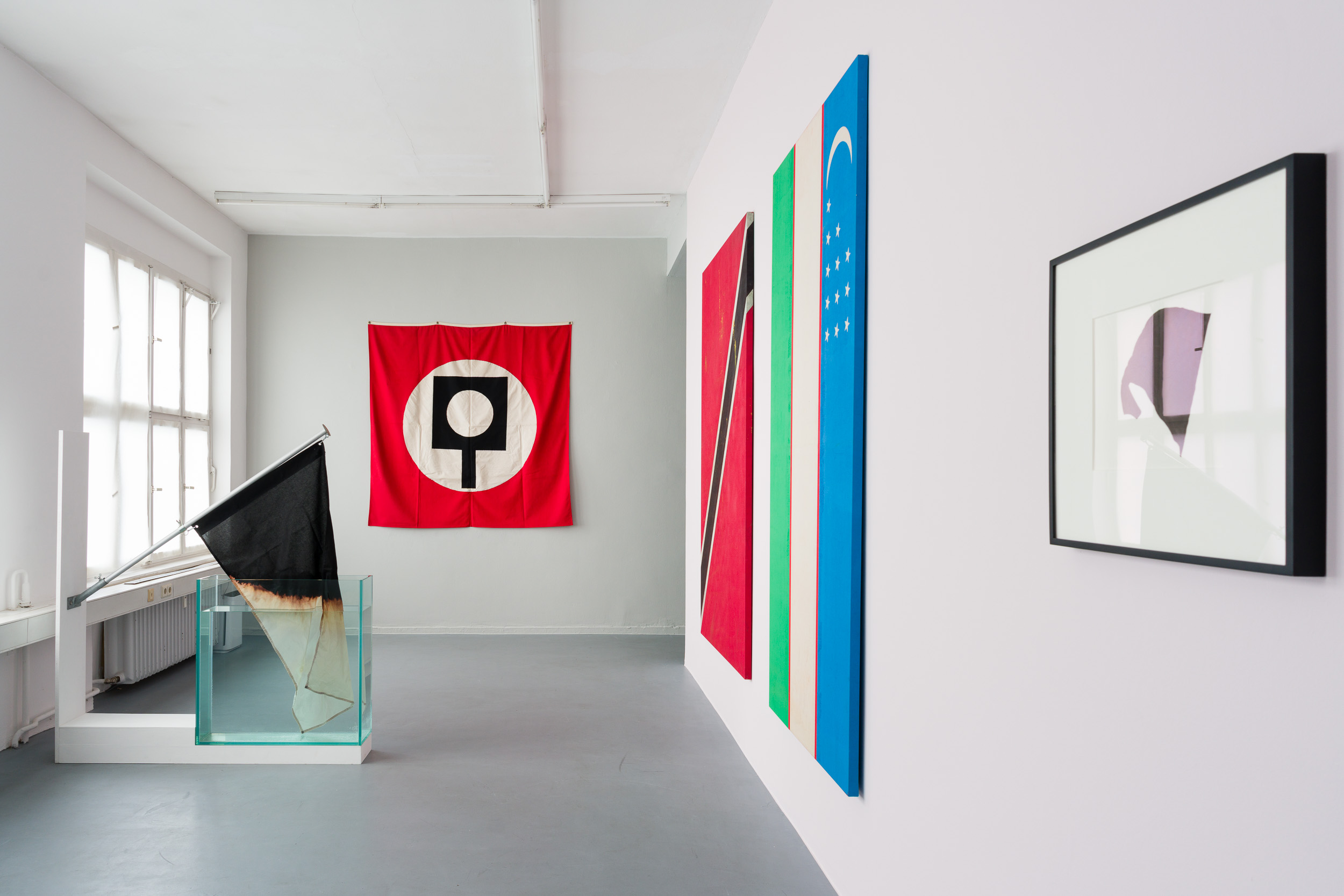
Exhibition view of huber.huber’s „Versuch“, 2017, Courtesy: the artists, and Matt Mullican’s „Sign Flag 36" by 72"“, 1980, Courtesy: the artist and privat collection, and Fredrik Værslev’s „Trinidad and Tobago“ and „Uzbekistan“, 2020, Courtesy: the artist and Mehdi Chouakri, Berlin, and Robert Longo’s „Study for Black Flag #5“, 1989, Courtesy: the artist and privat collection, photo: Bernhard Kahrmann.
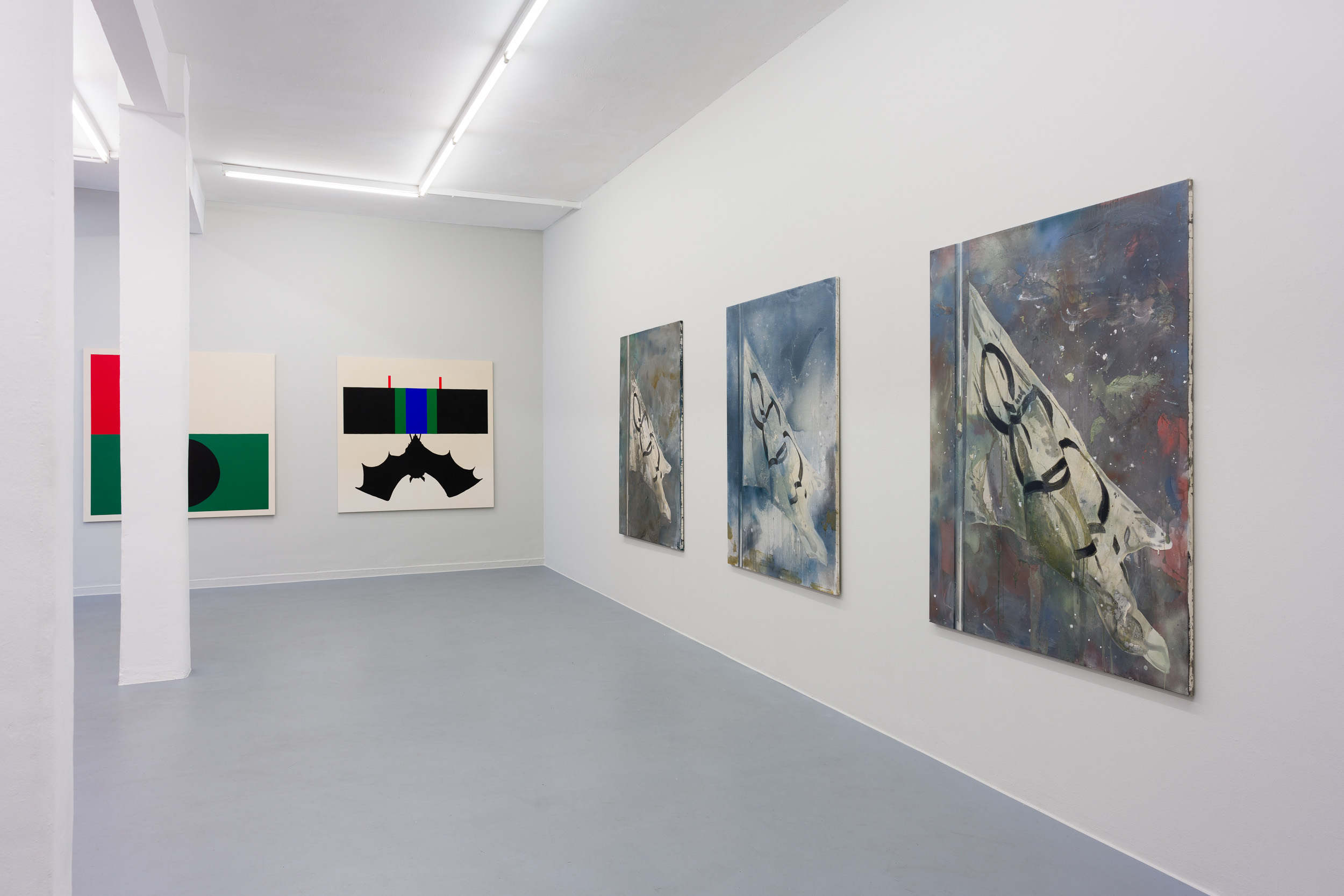
Exhibition view of Samson Kambalu’s „Untitled“ and „Bat Down Nation Green“, 2022, Courtesy: the artist and Andersen’s Contemporary, Copenhagen, and Frank Ahlgrimm’s series „Halbmast“, 2011, photo: Bernhard Kahrmann.
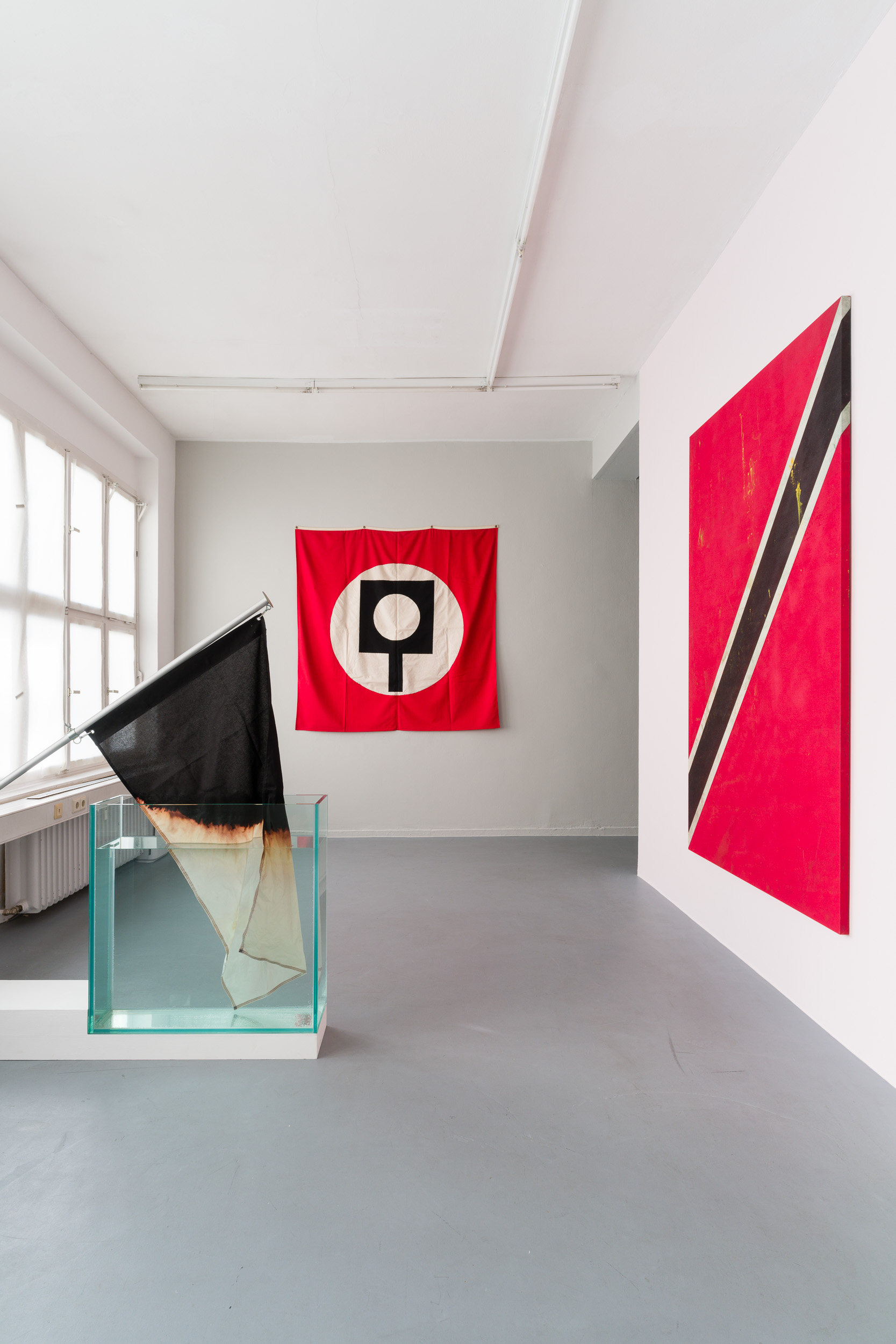
Exhibition view of huber.huber’s „Versuch“, 2017, Courtesy: the artists, and Matt Mullican’s „Sign Flag 36" by 72"“, 1980, Courtesy: the artist and privat collection, and Fredrik Værslev’s „Trinidad and Tobago“, 2020, Courtesy: the artist and Mehdi Chouakri, Berlin, photo: Bernhard Kahrmann.
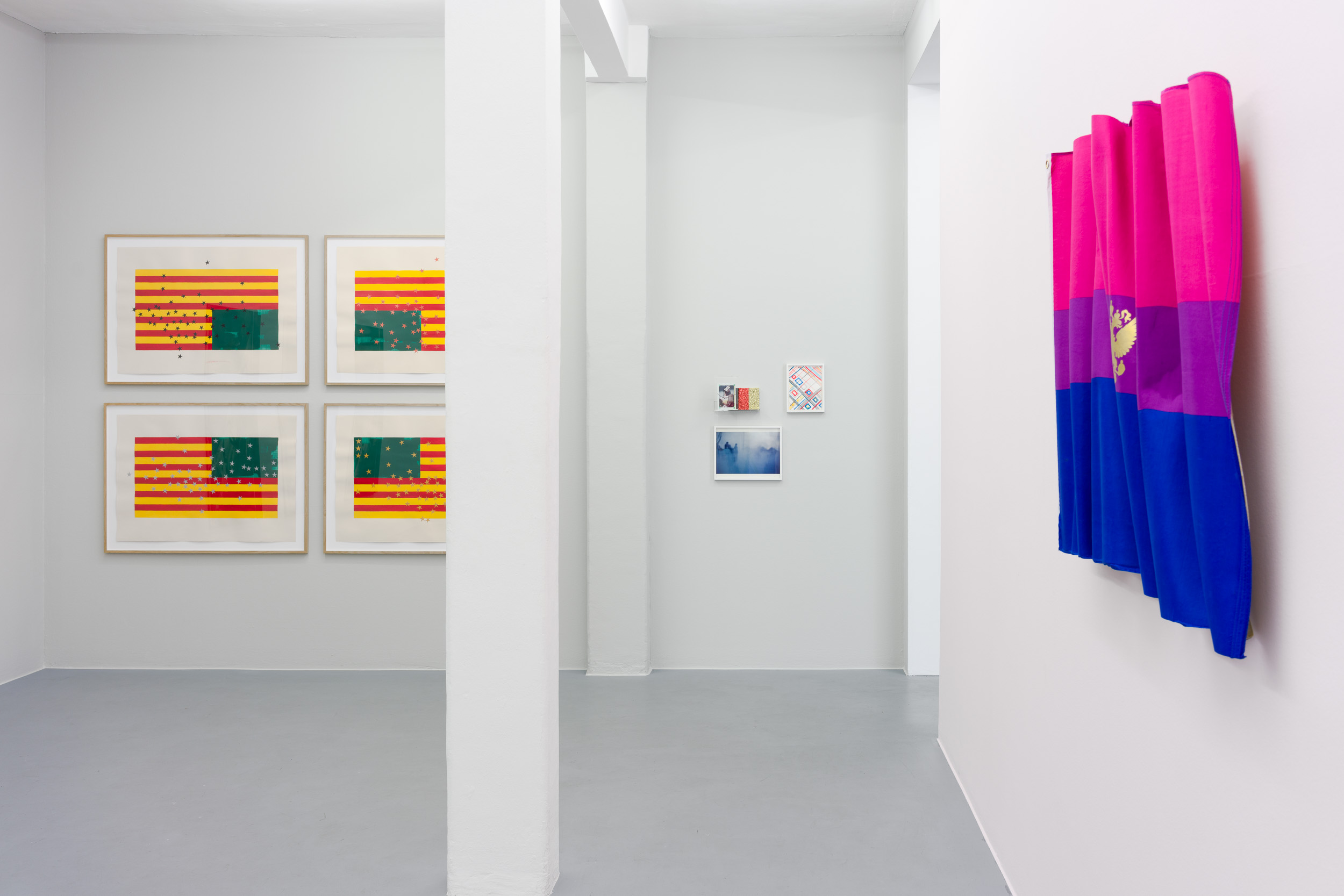
Exhibition view of Nú Barreto’s „Tous les chemins mènent en Afrique“, 2022, Courtesy: the artist and Galerie Nathalie Obadia, Paris/Brussels, and Josephine Meckseper’s „Untitled (Shelf #8)“, 2002, Courtesy: the artist and privat collection, and Slavs and Tatars’ „Bicephalic“, 2018, Courtesy: the artist and Kraupa-Tuskany Zeidler, Berlin, photo: Bernhard Kahrmann.
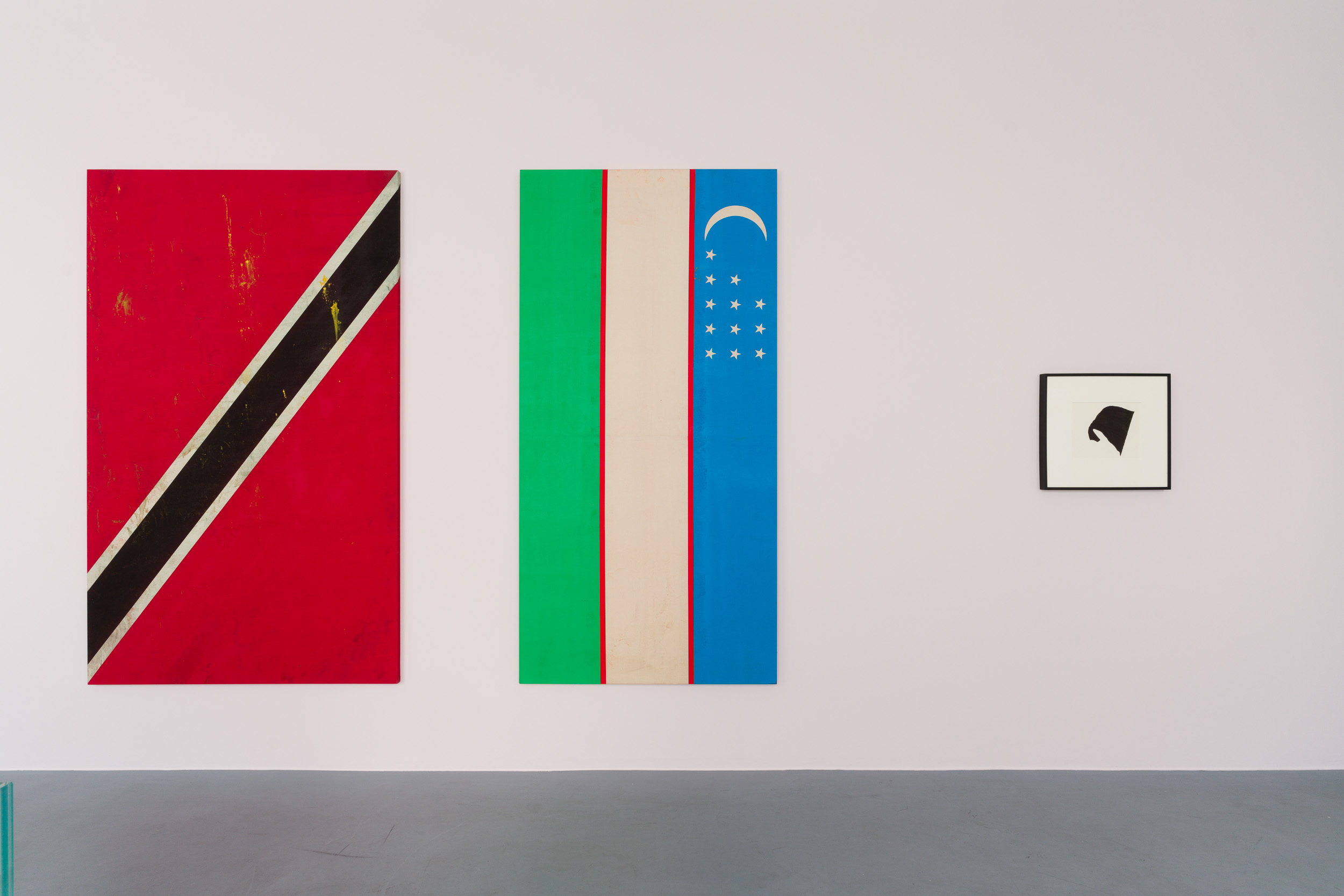
Exhibition view of Fredrik Værslev’s „Trinidad and Tobago“ and „Uzbekistan“, 2020, Courtesy: the artist and Mehdi Chouakri, Berlin, and Robert Longo’s „Study for Black Flag #5“, 1989, Courtesy: the artist and privat collection, photo: Bernhard Kahrmann.
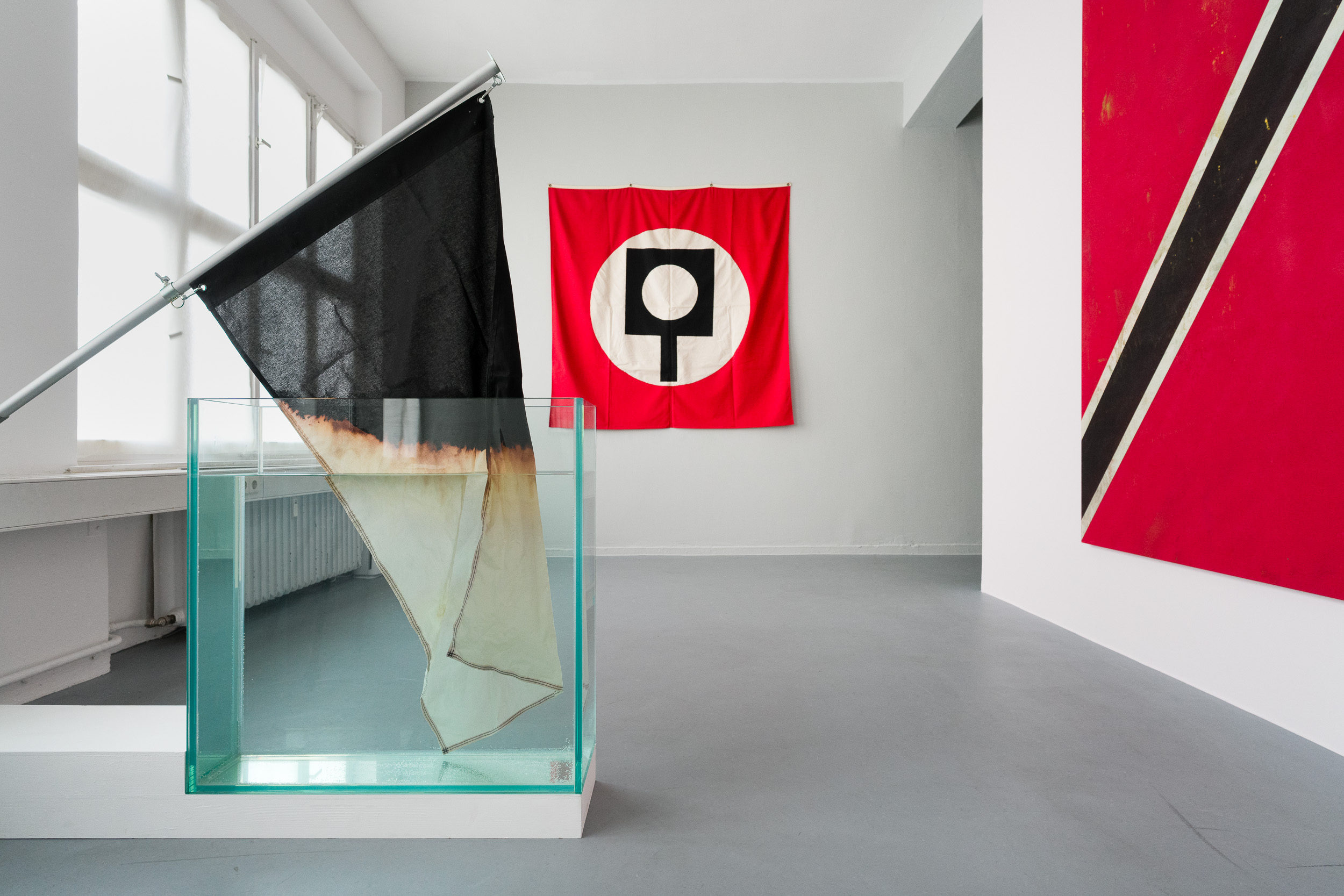
Exhibition view of huber.huber’s „Versuch“, 2017, Courtesy: the artists, and Matt Mullican’s „Sign Flag 36" by 72"“, 1980, Courtesy: the artist and privat collection, and Fredrik Værslev’s „Trinidad and Tobago“, 2020, Courtesy: the artist and Mehdi Chouakri, Berlin, photo: Bernhard Kahrmann.
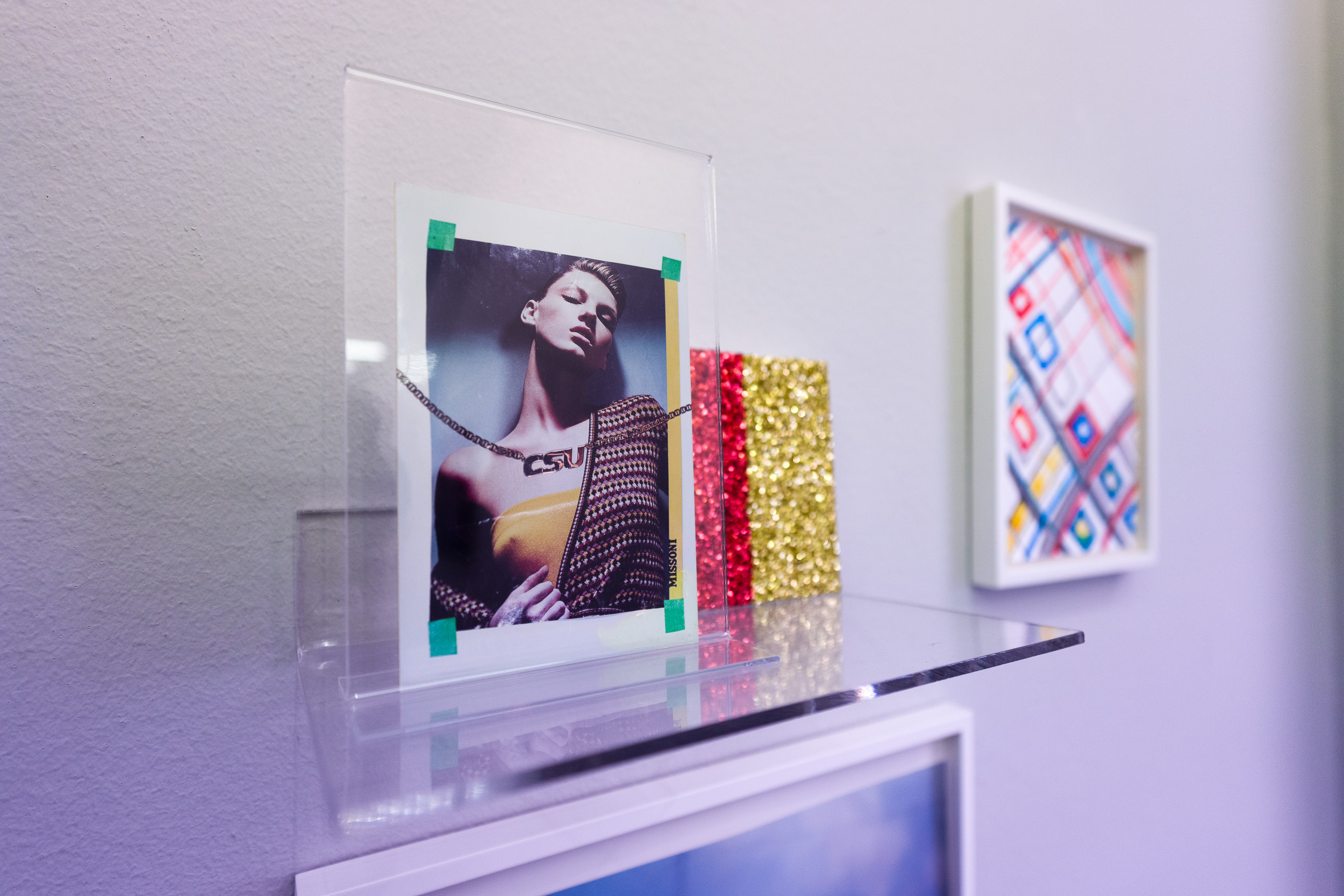
Detail of Josephine Meckseper’s „Untitled (Shelf #8)“, 2002, mixed media, Courtesy: the artist and privat collection, photo: Bernhard Kahrmann.
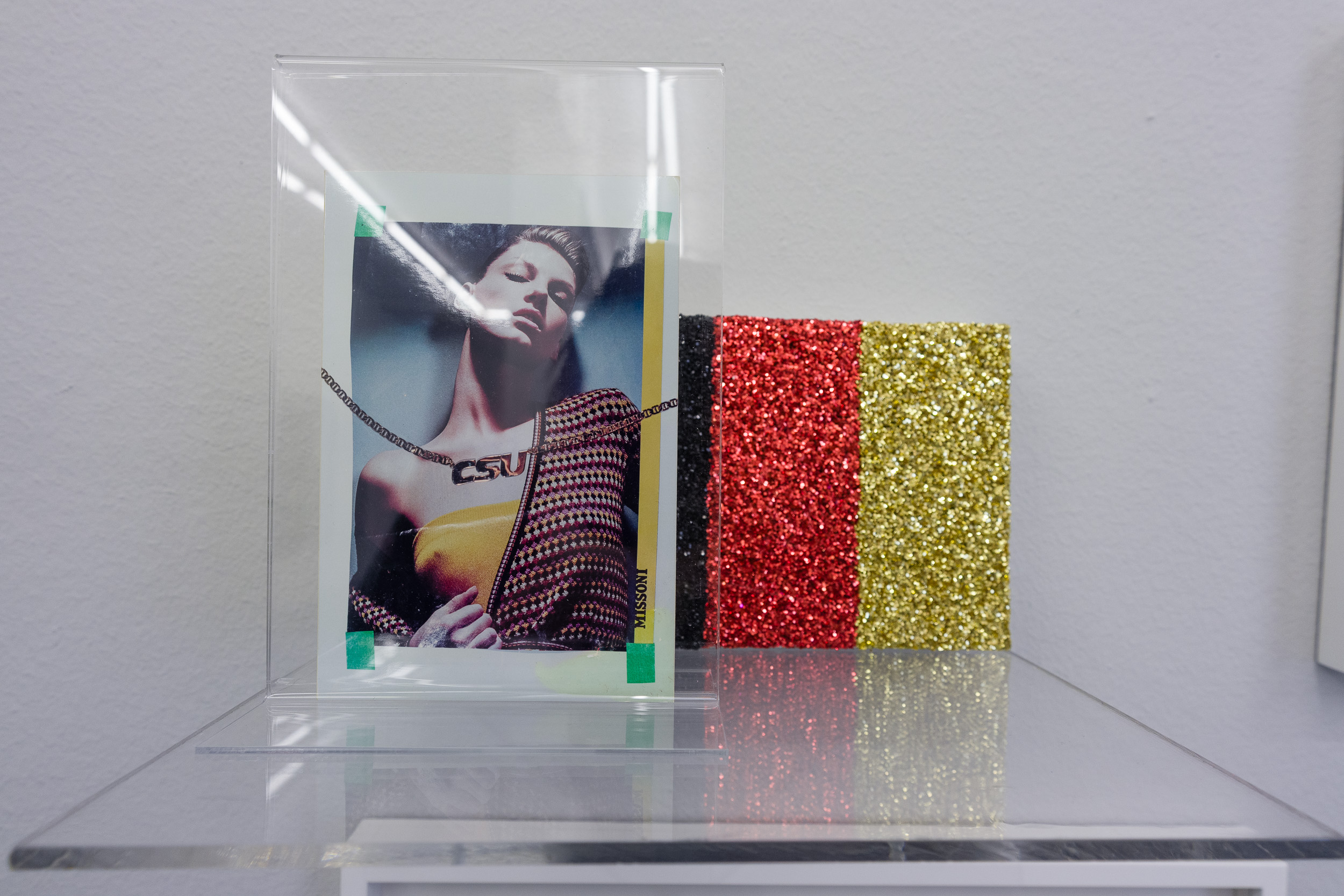
Detail of Josephine Meckseper’s „Untitled (Shelf #8)“, 2002, mixed media, Courtesy: the artist and privat collection, photo: Bernhard Kahrmann.

Exhibition view of Matt Mullican’s „Sign Flag 36" by 72"“, 1980, Courtesy: the artist and privat collection, and huber.huber’s „Versuch“, 2017, Courtesy: the artists, and Fredrik Værslev’s „Trinidad and Tobago“, 2020, Courtesy: the artist and Mehdi Chouakri, Berlin, photo: Bernhard Kahrmann.
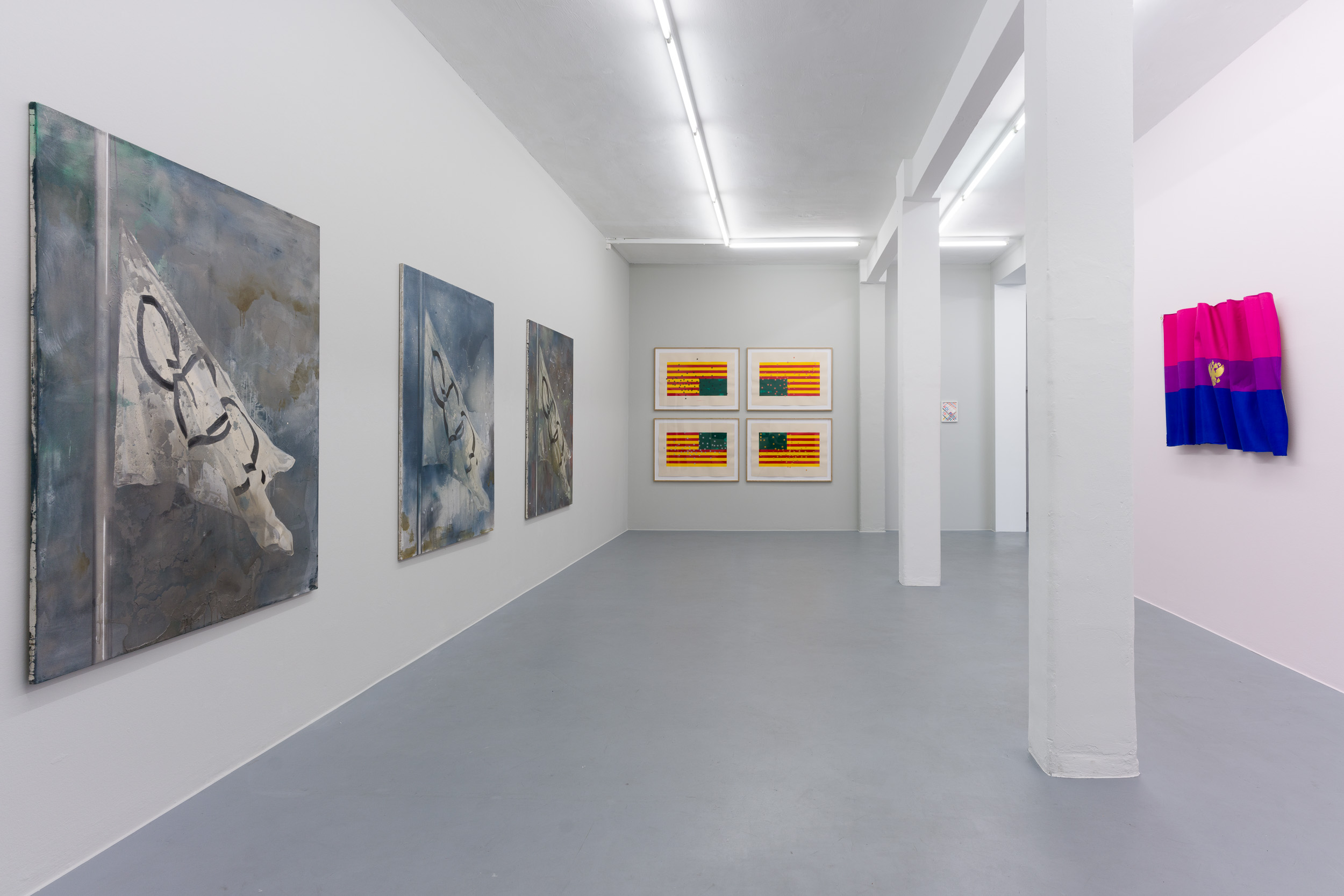
Exhibition view of Frank Ahlgrimm’s series „Halbmast“, 2011, and Nú Barreto’s „Tous les chemins mènent en Afrique“, 2022, Courtesy: the artist and Galerie Nathalie Obadia, Paris/Brussels, and Slavs and Tatars’ „Bicephalic“, 2018, Courtesy: the artist and Kraupa-Tuskany Zeidler, Berlin, photo: Bernhard Kahrmann.

